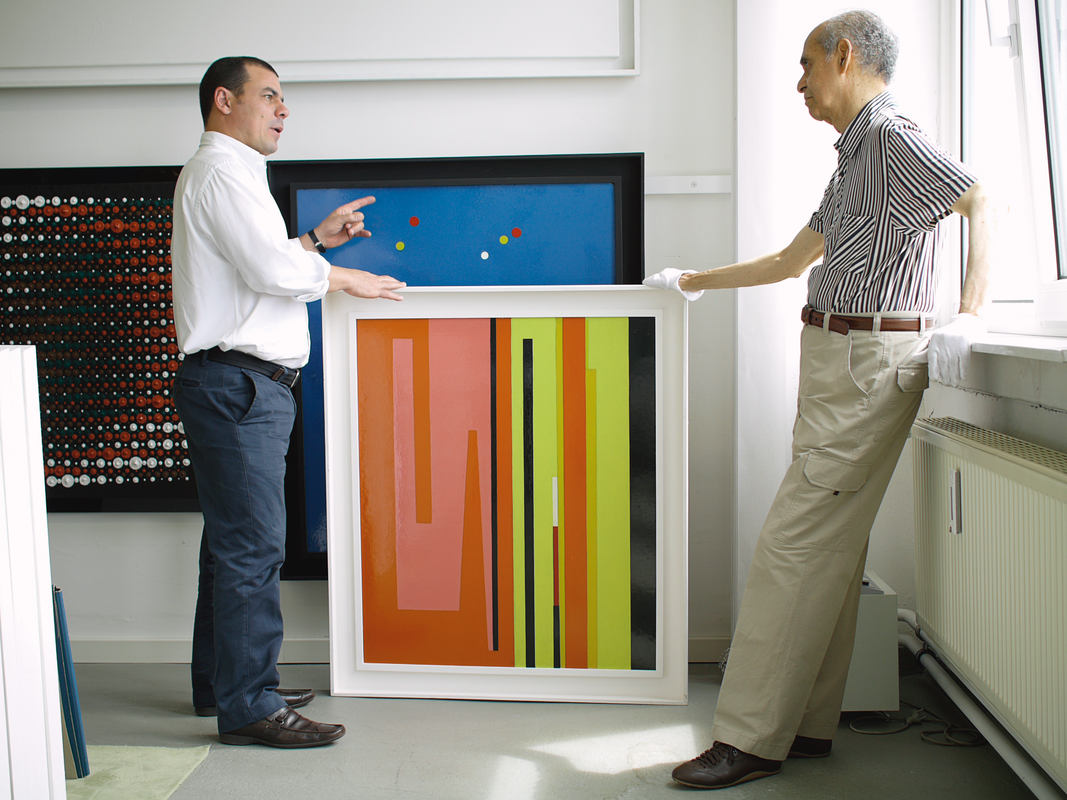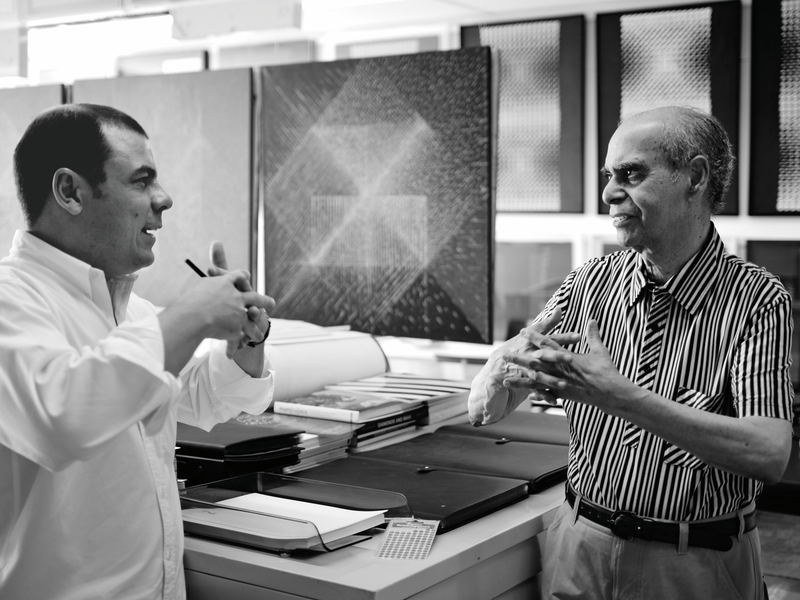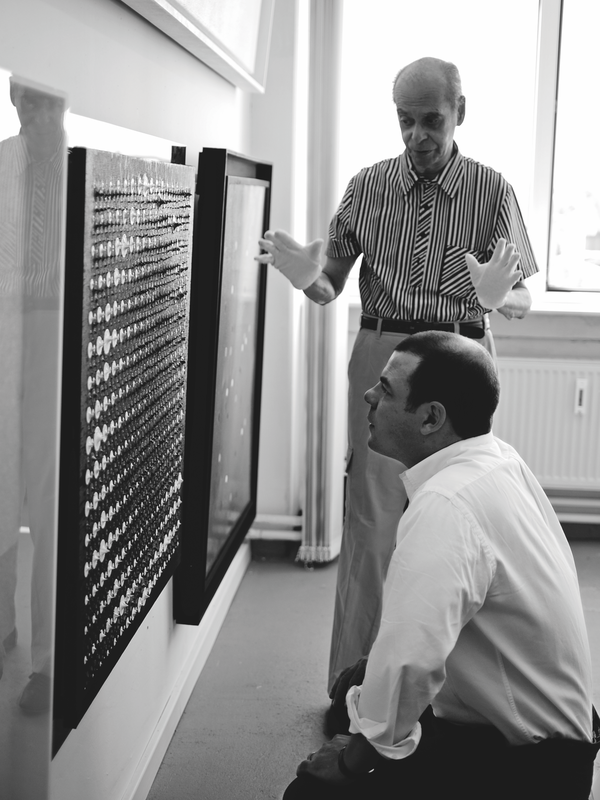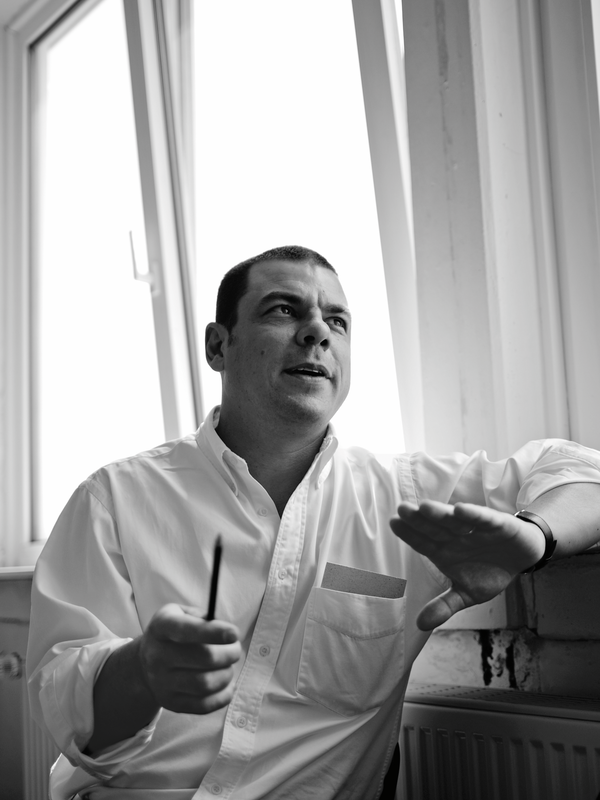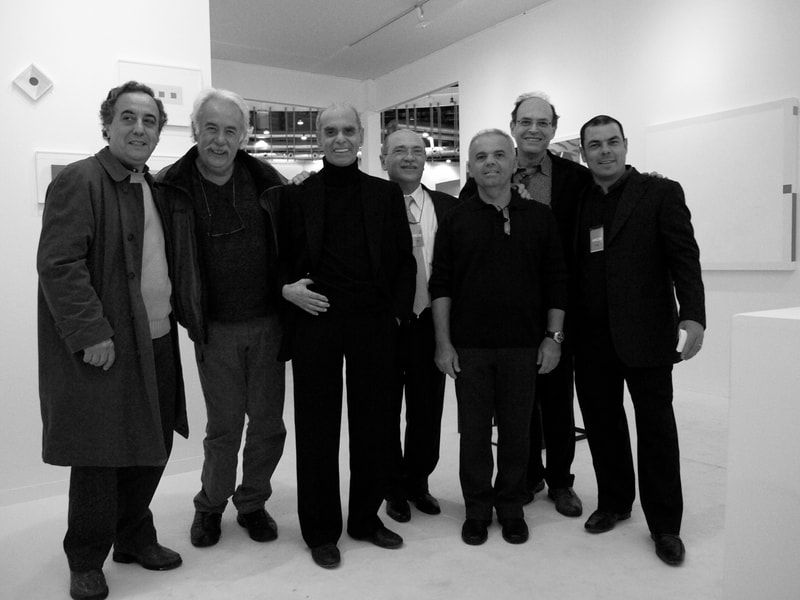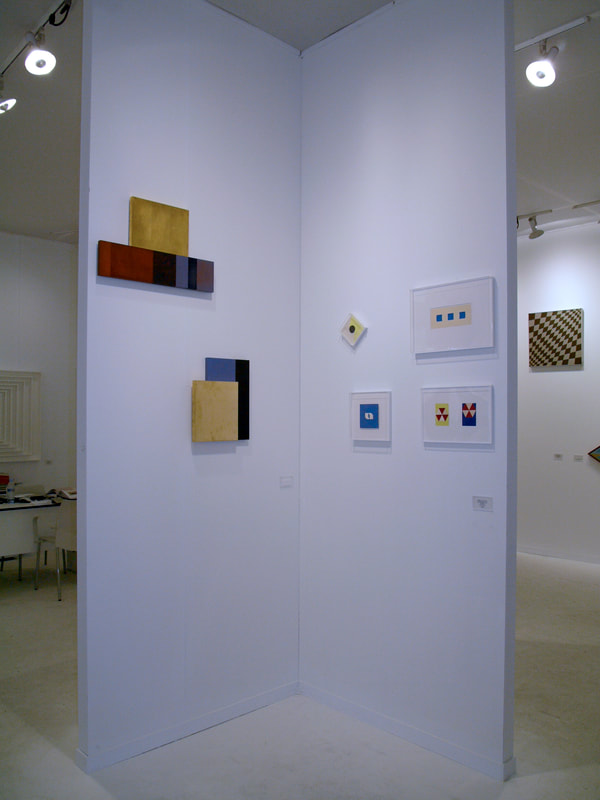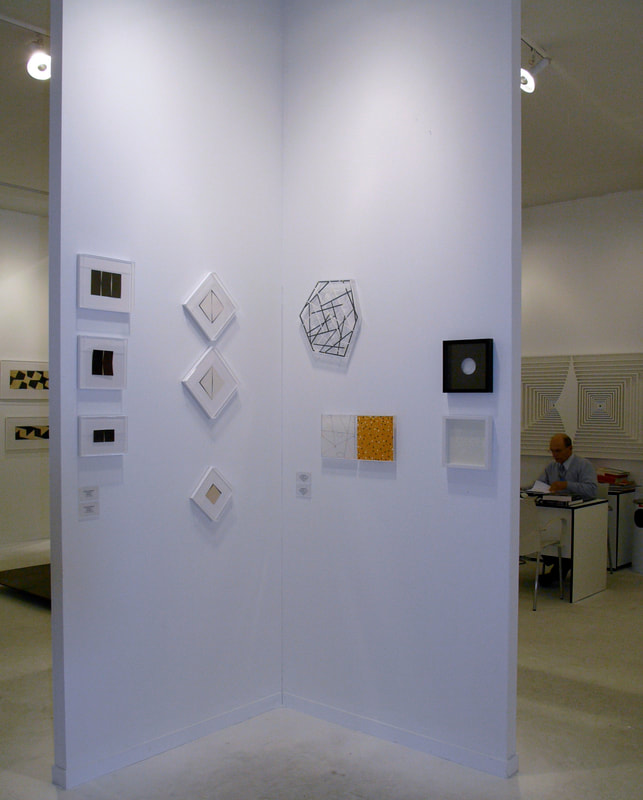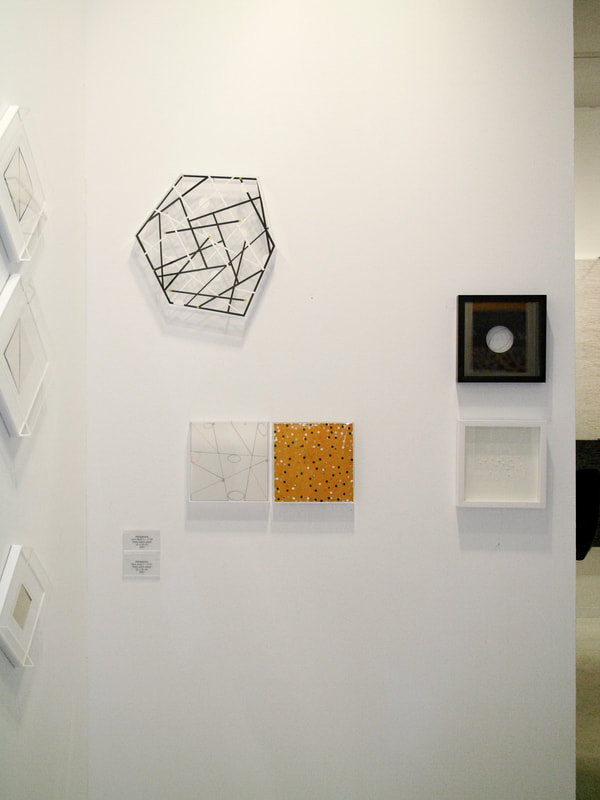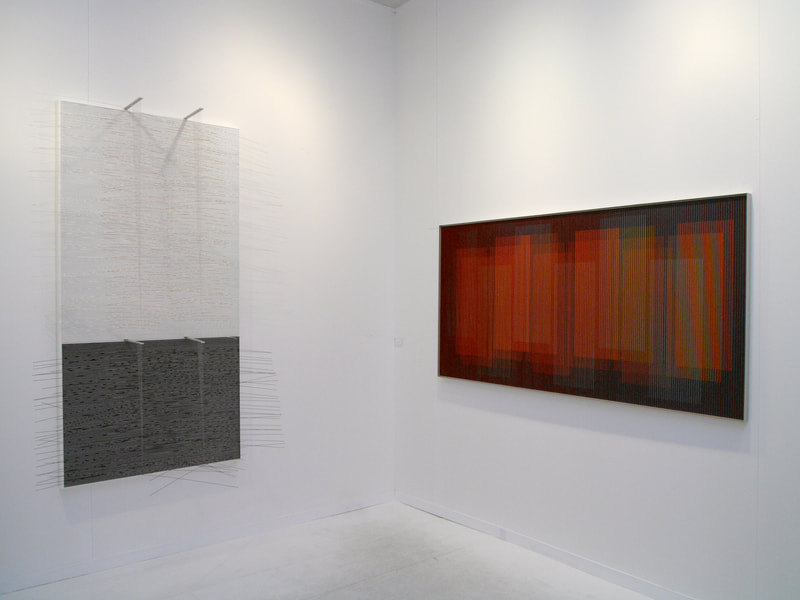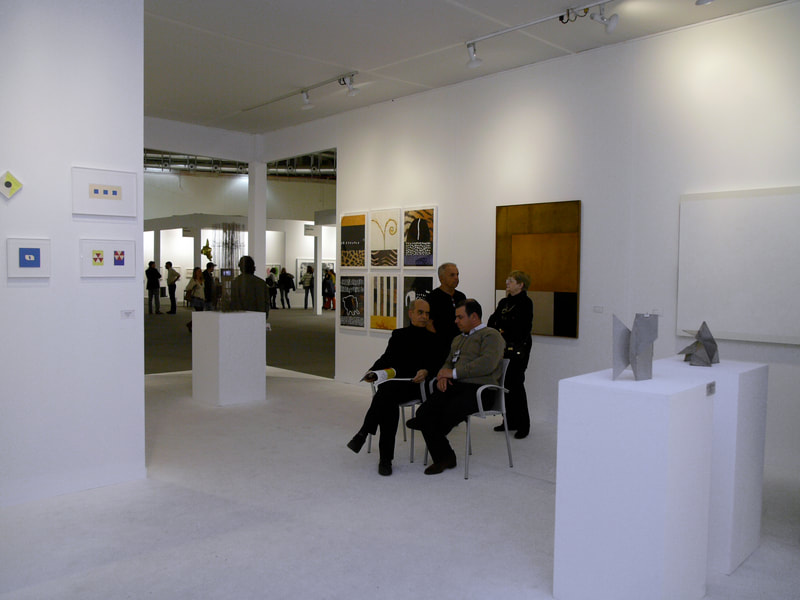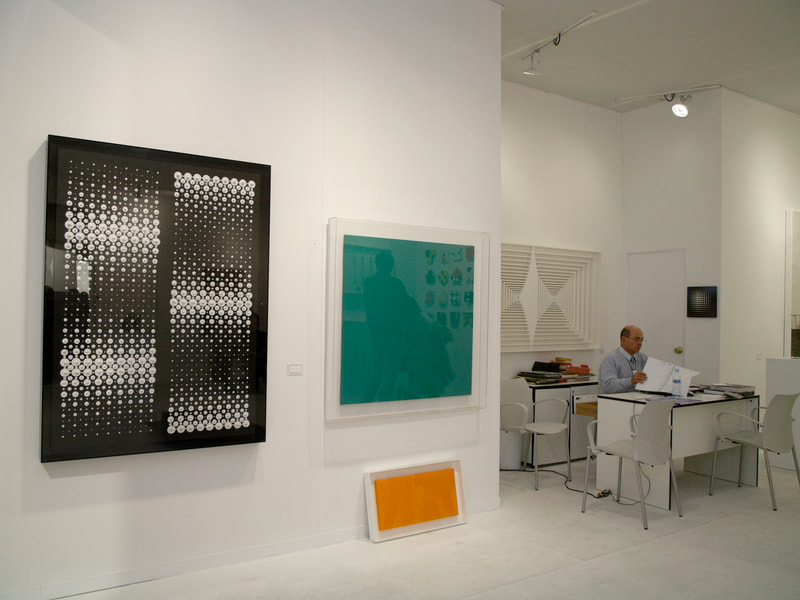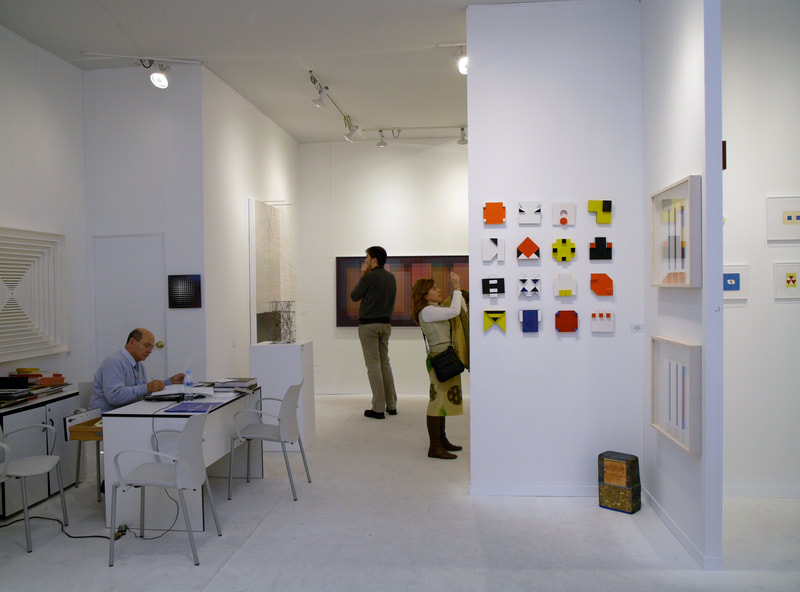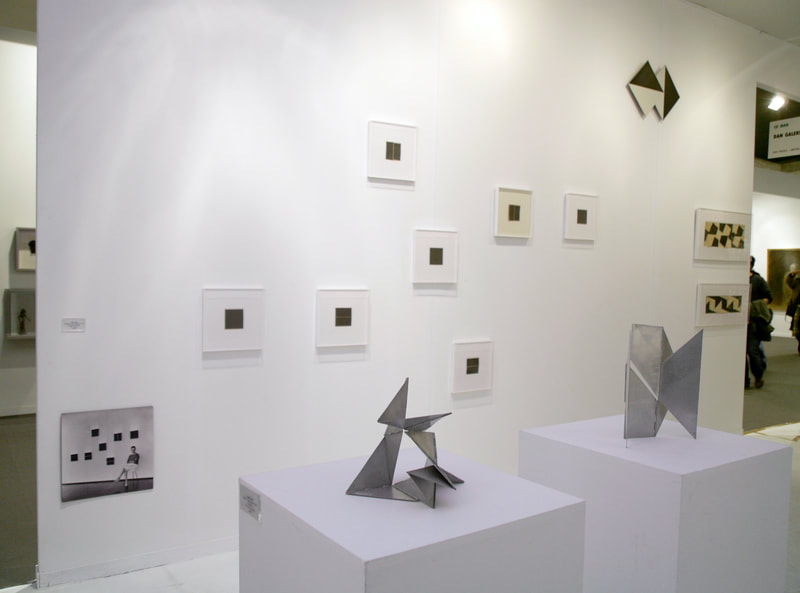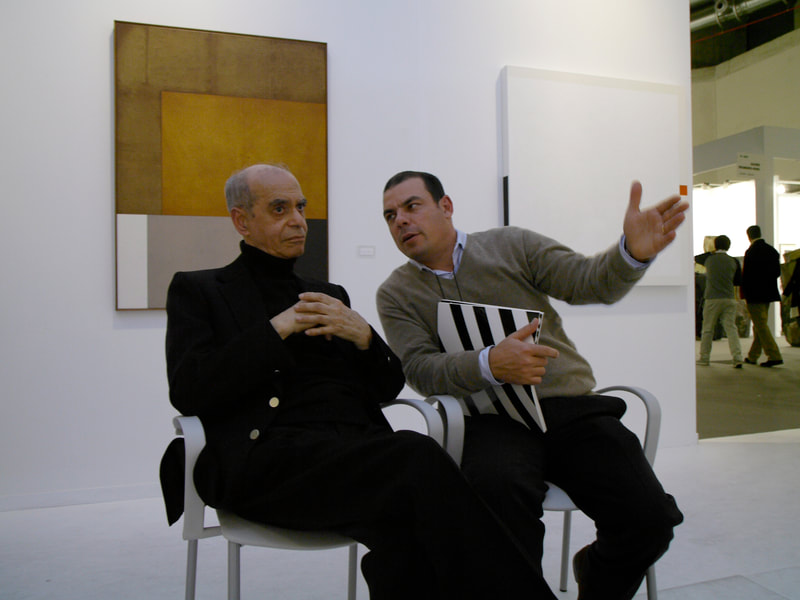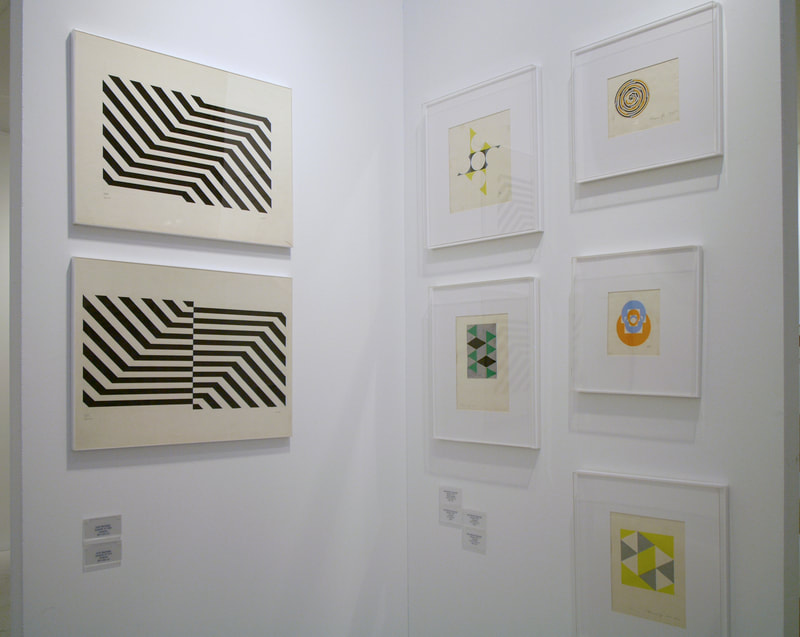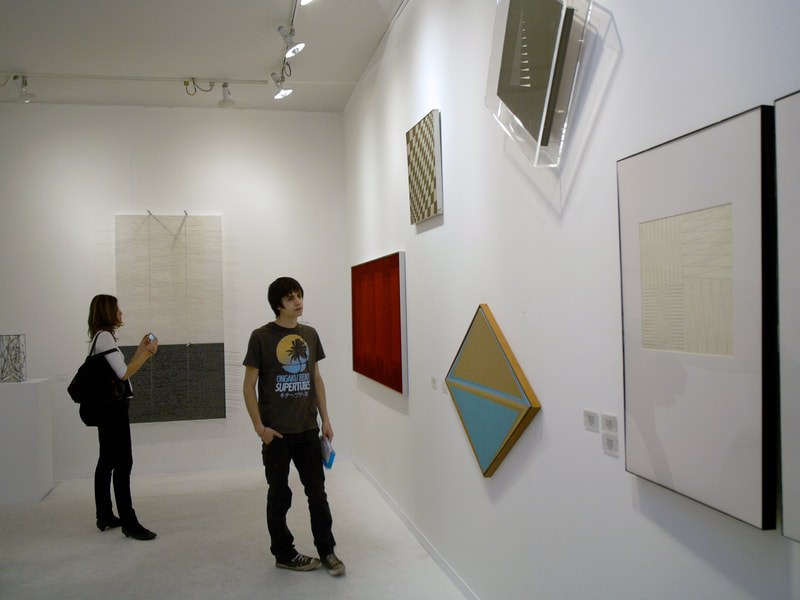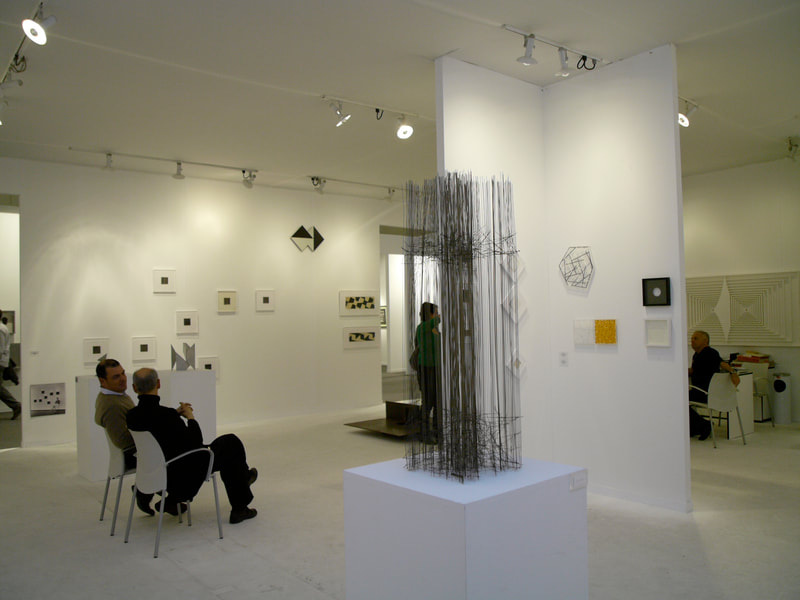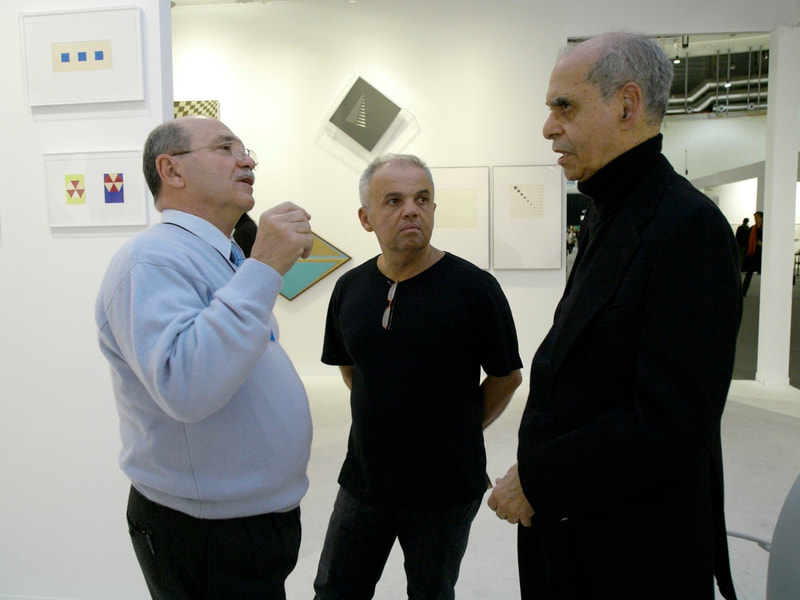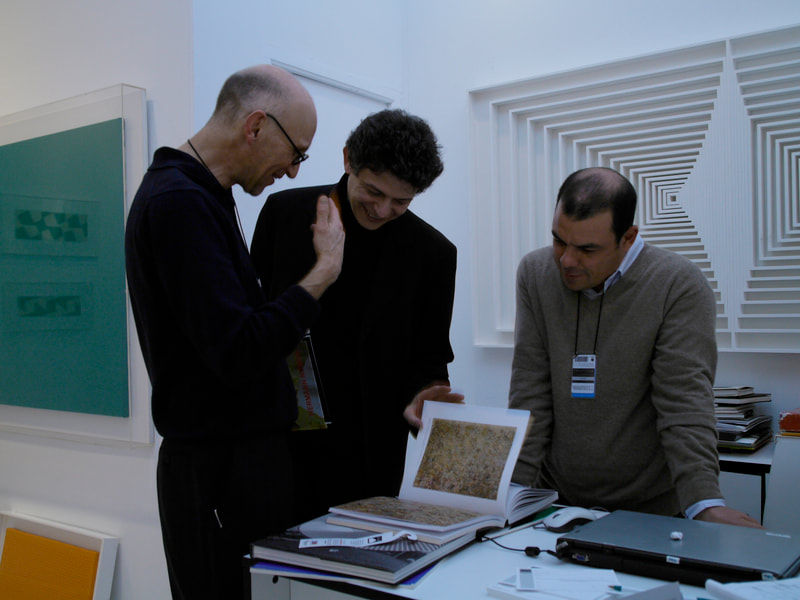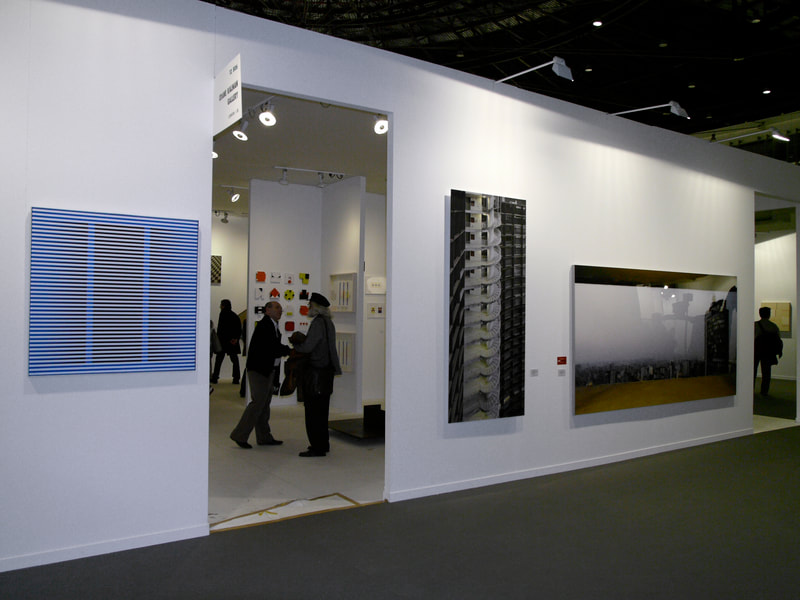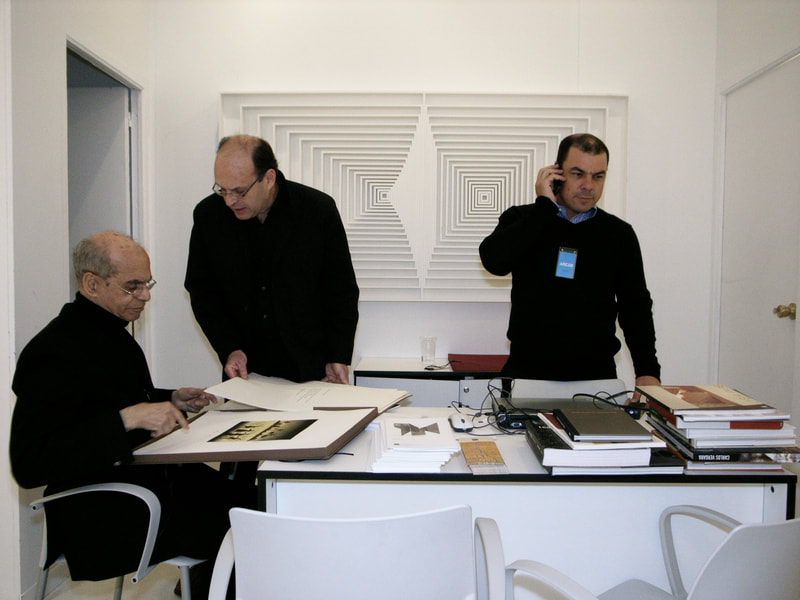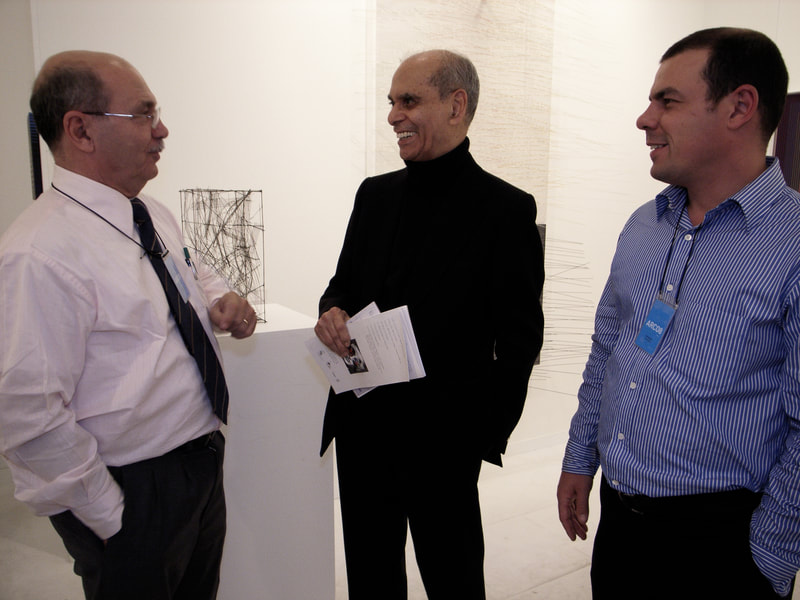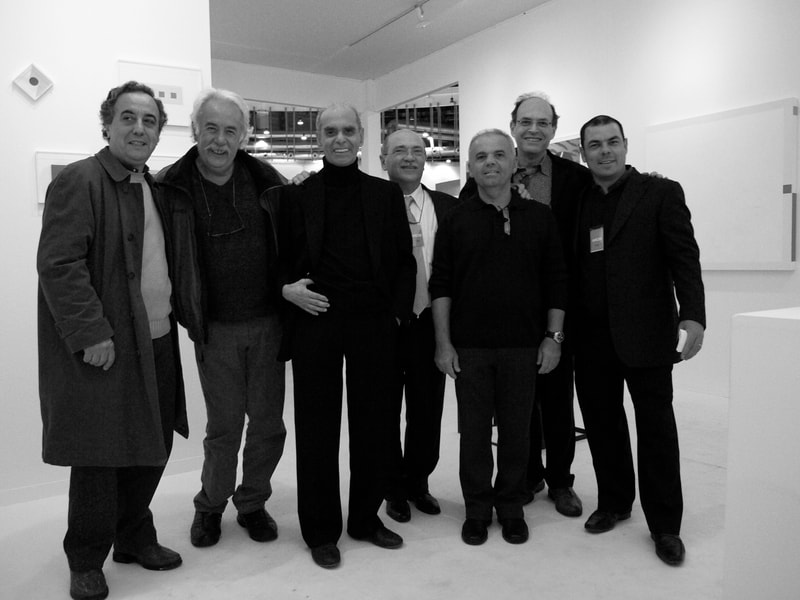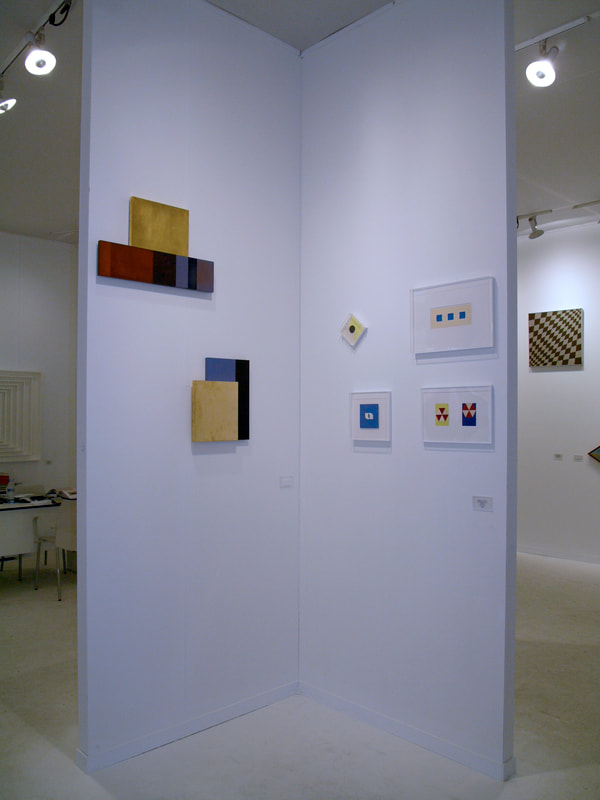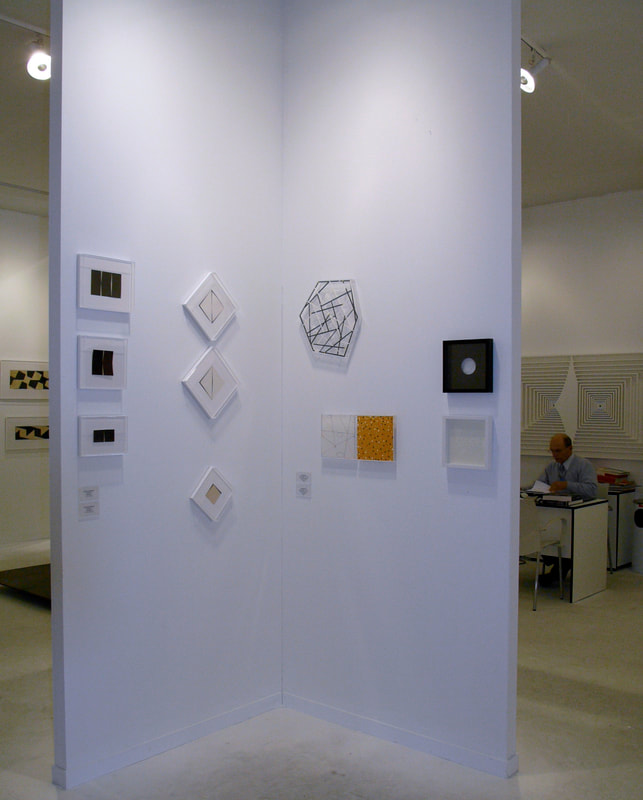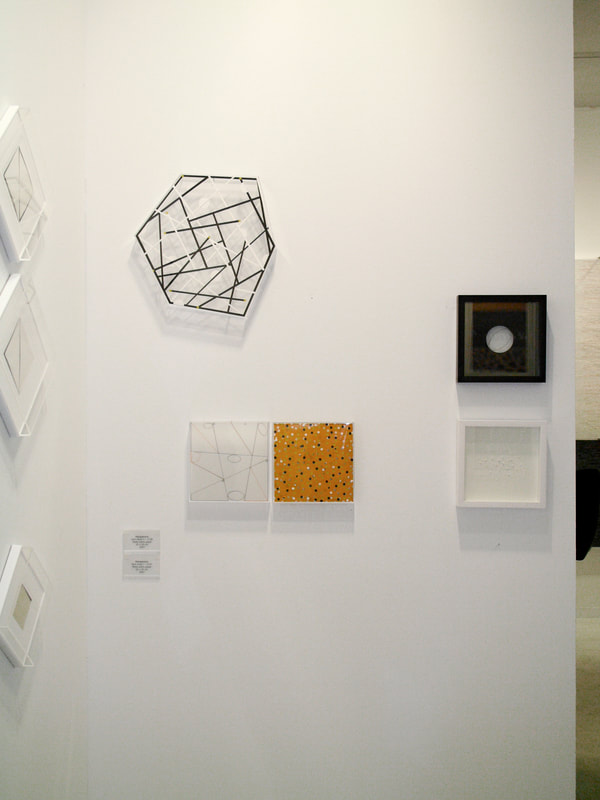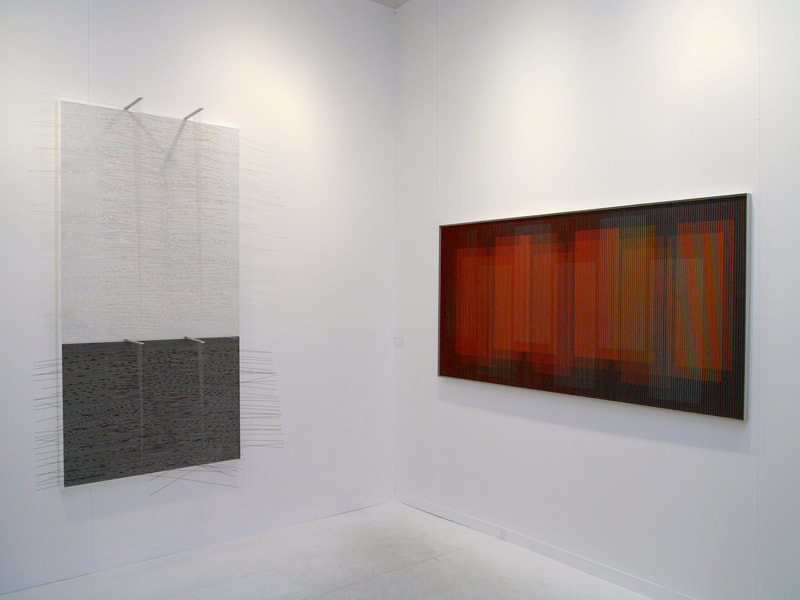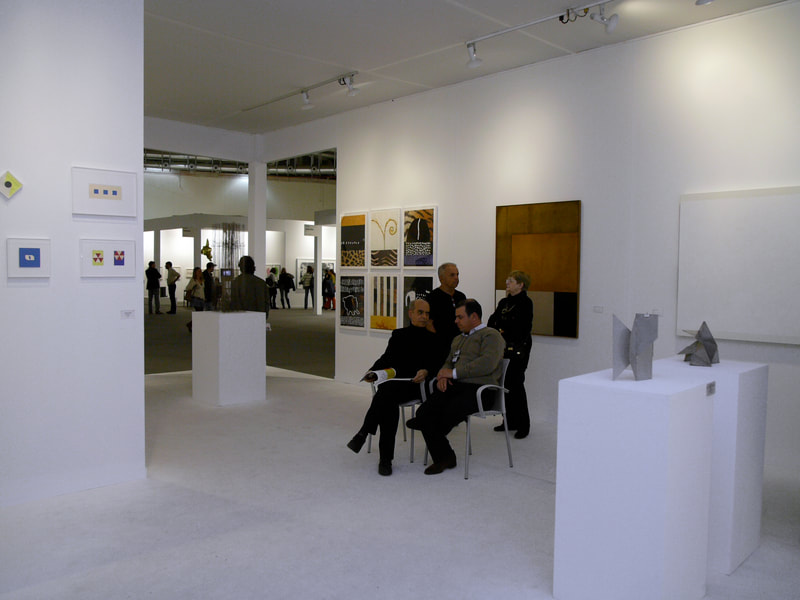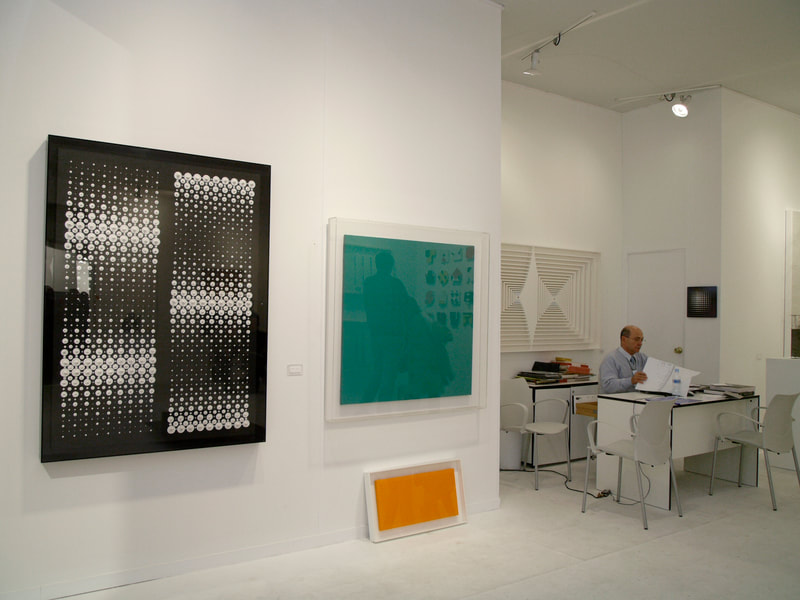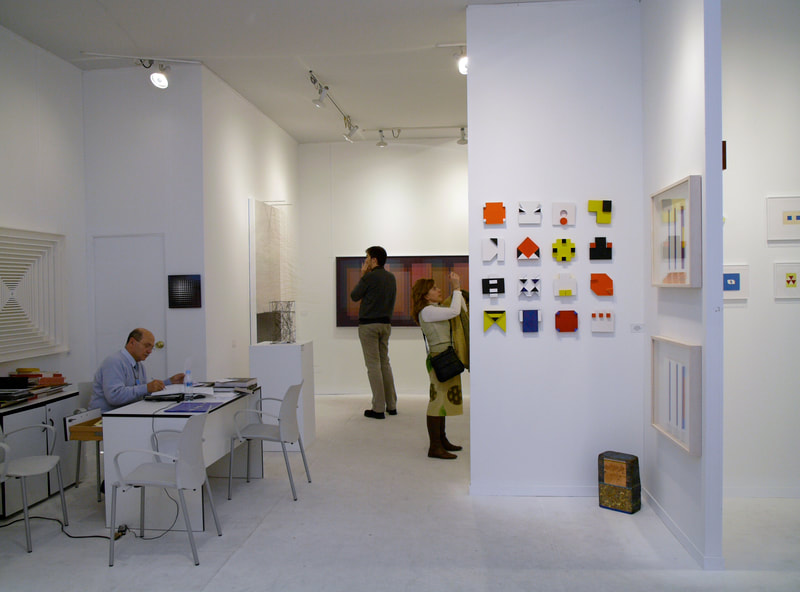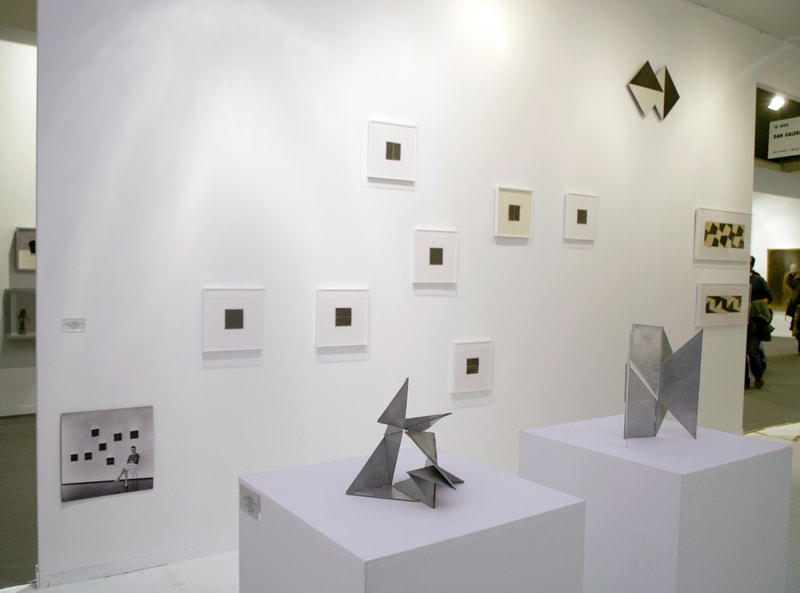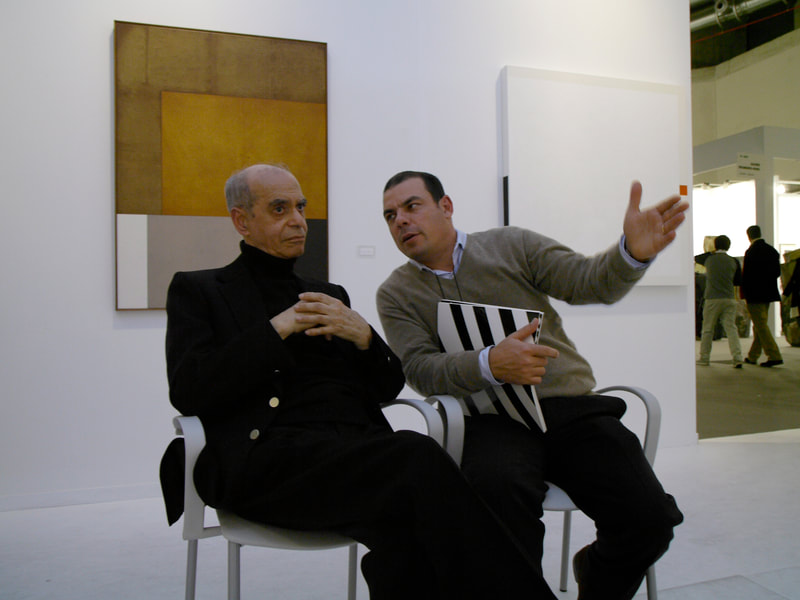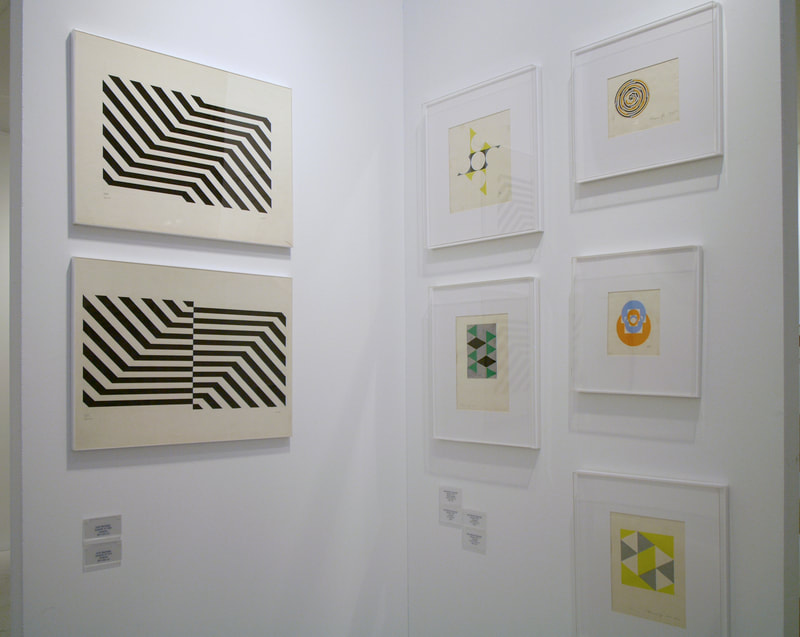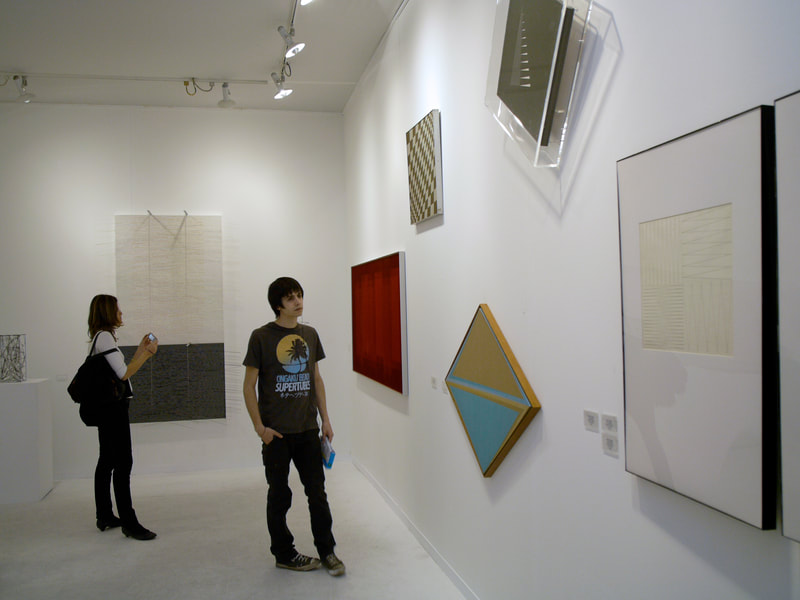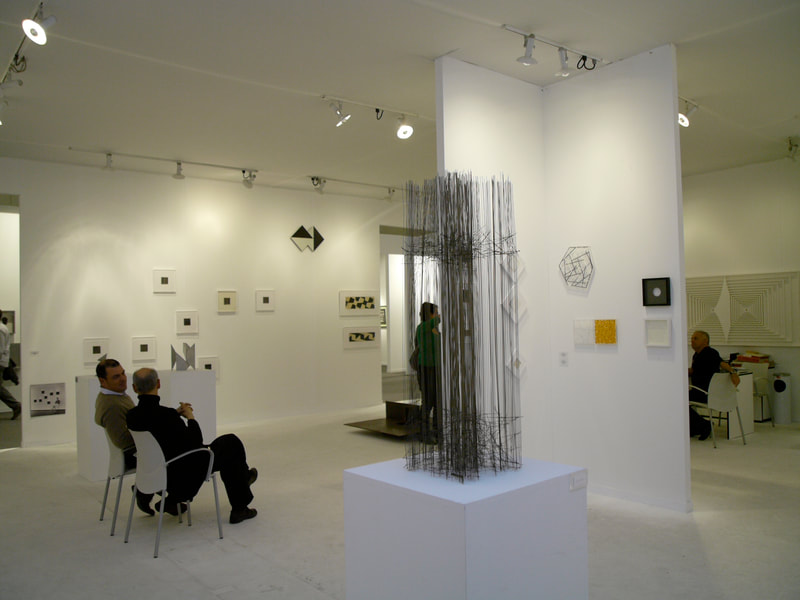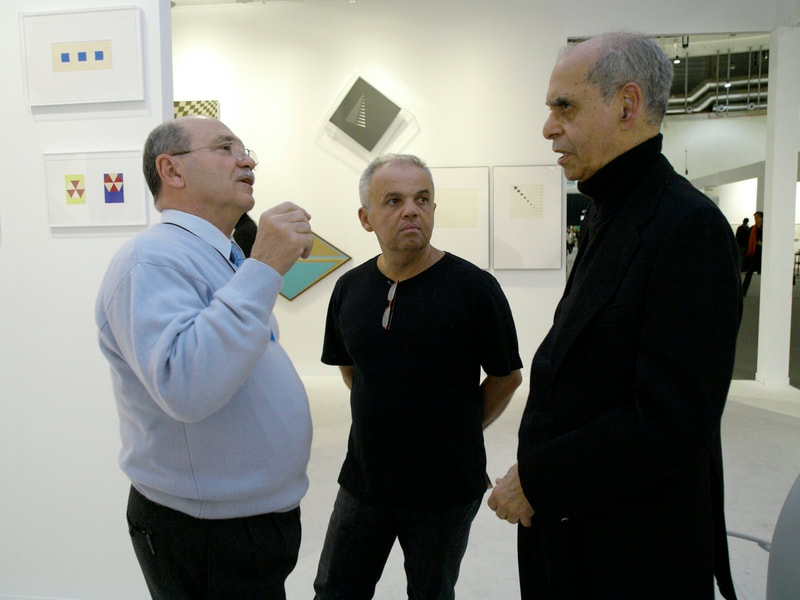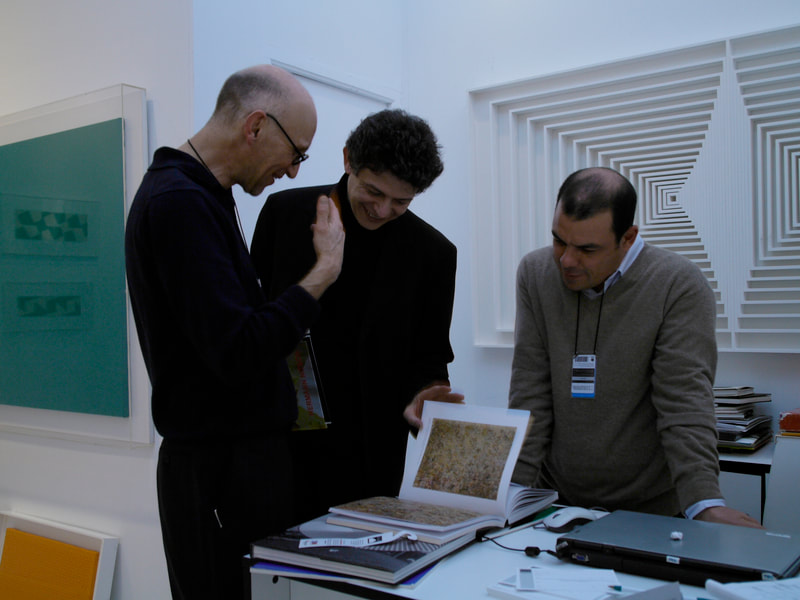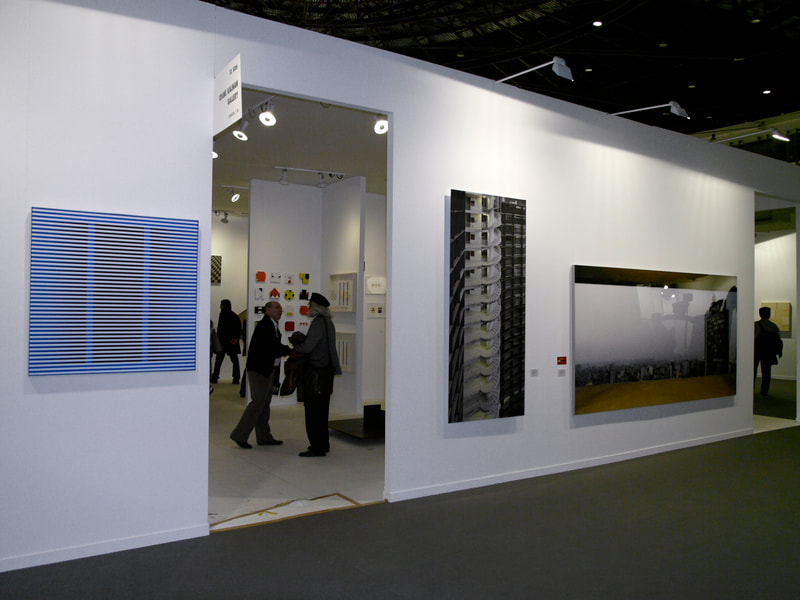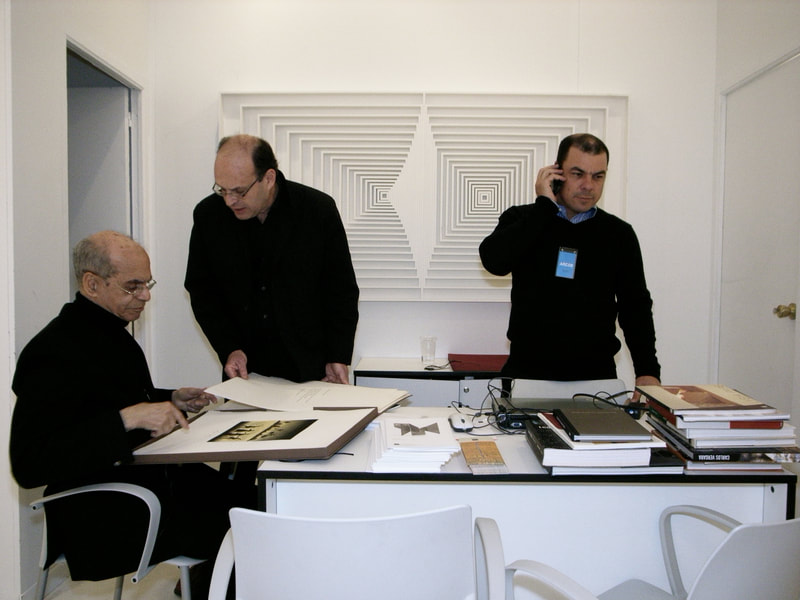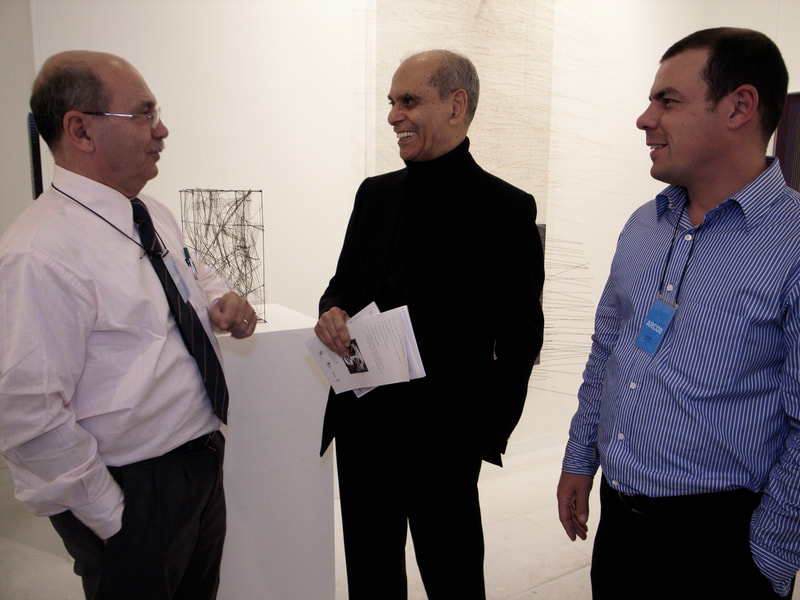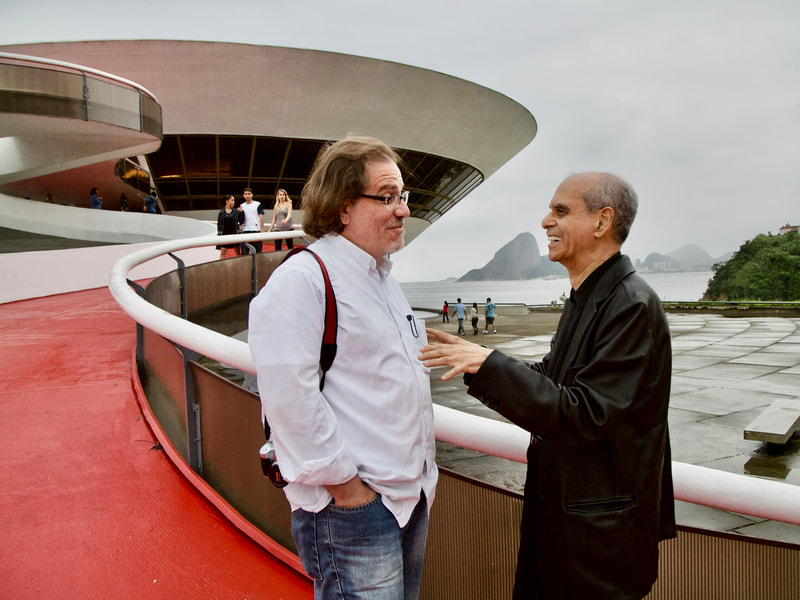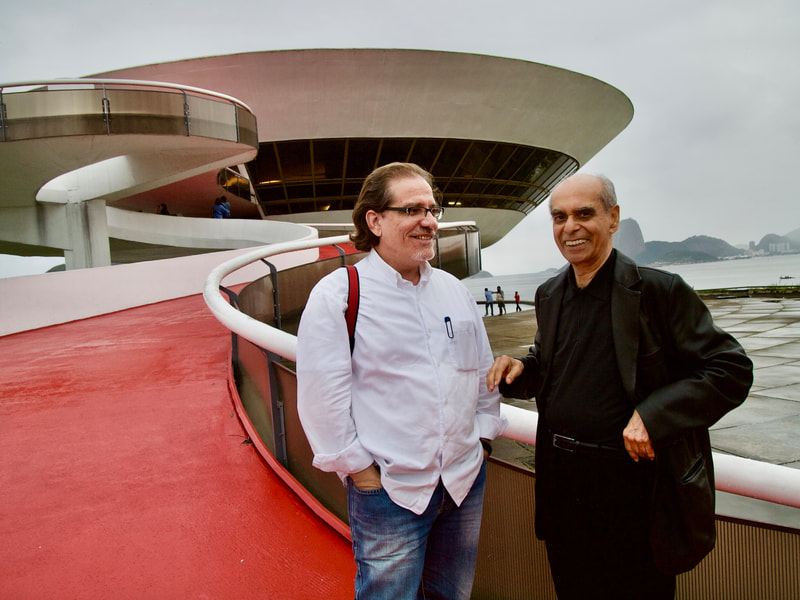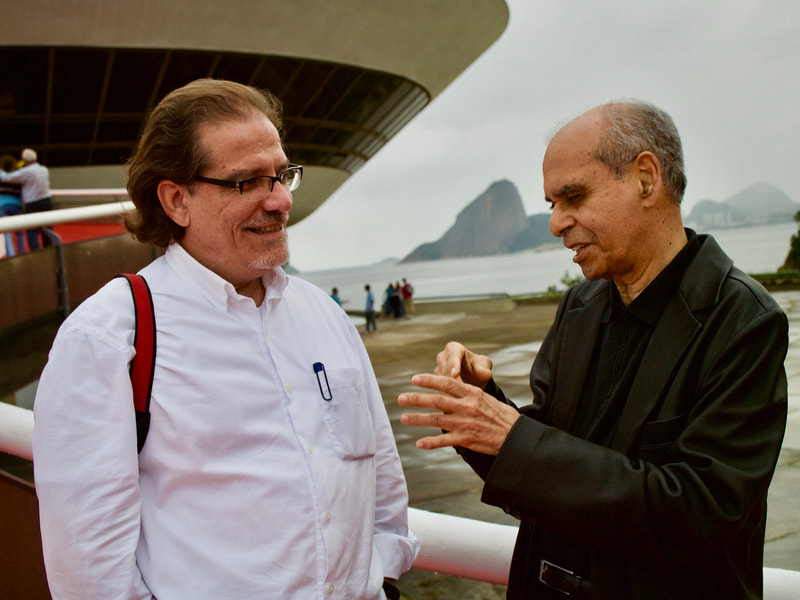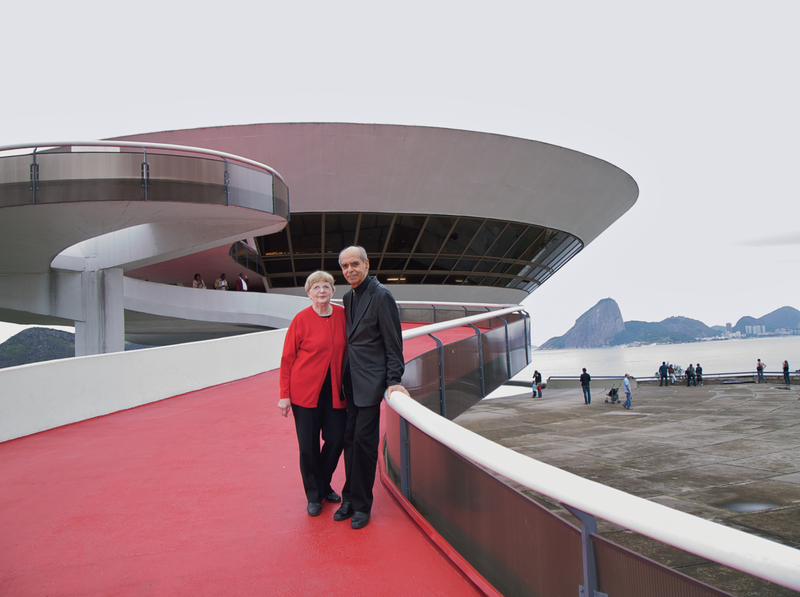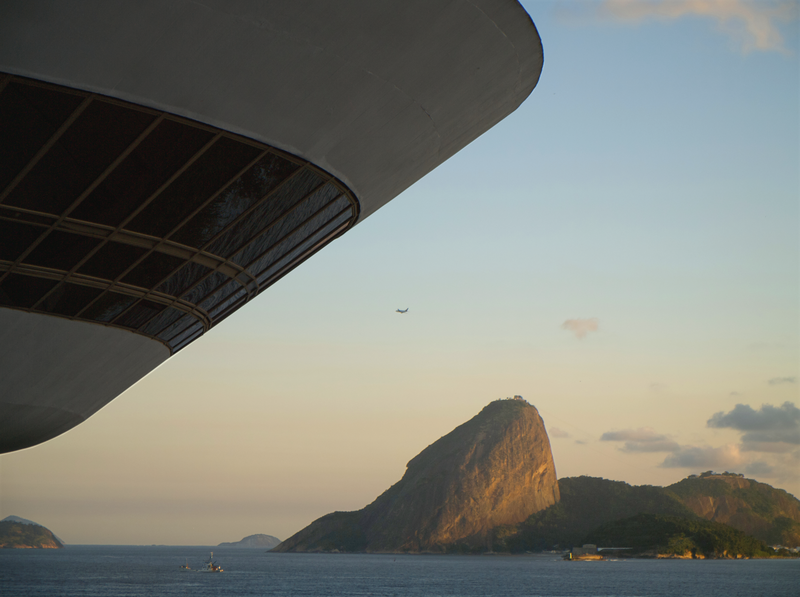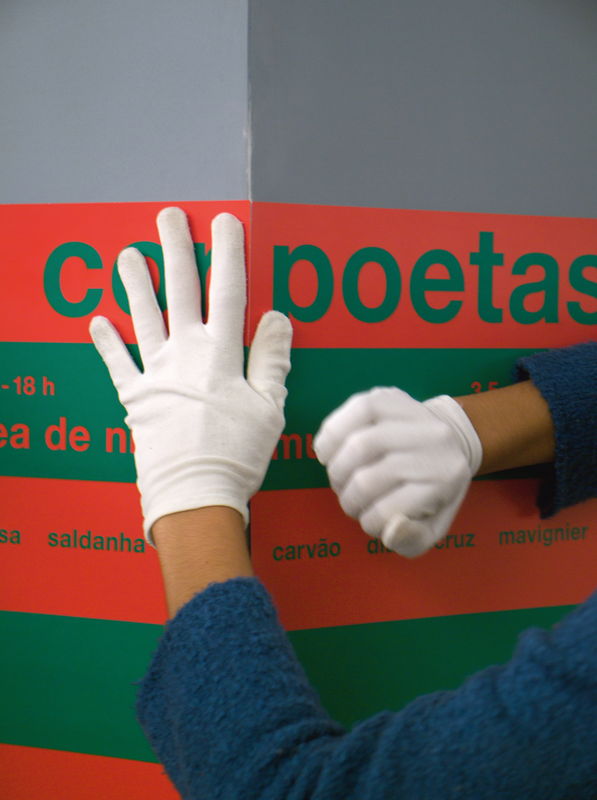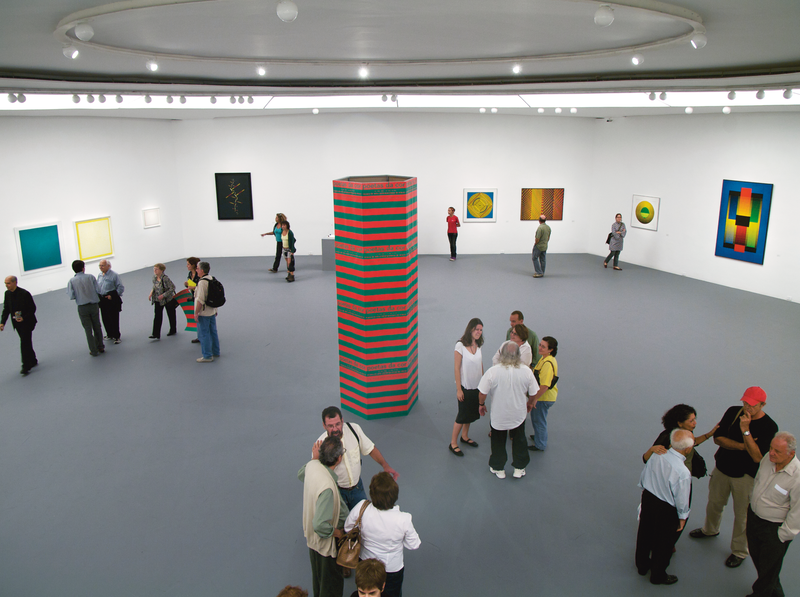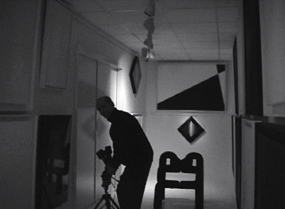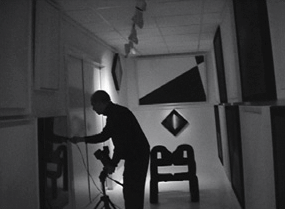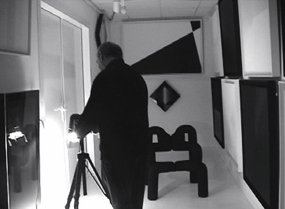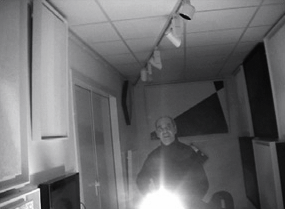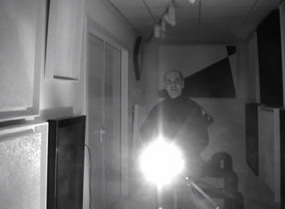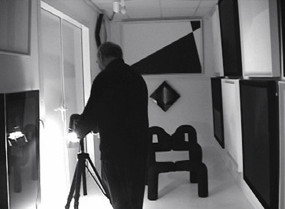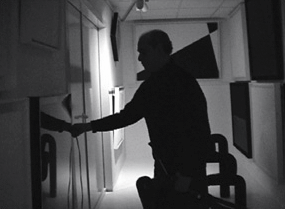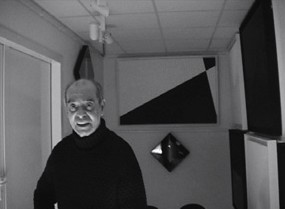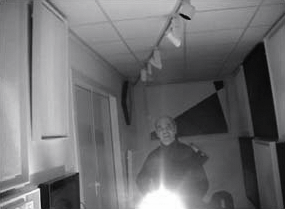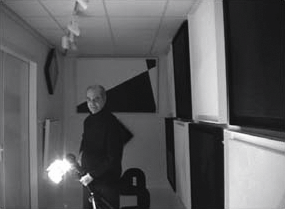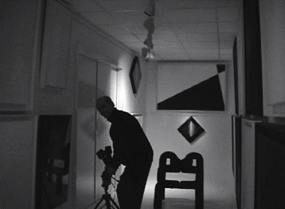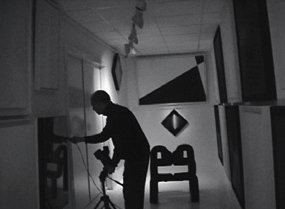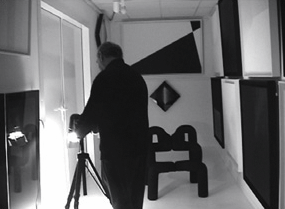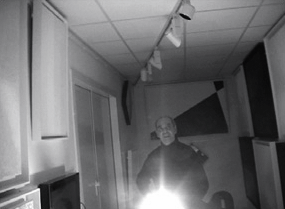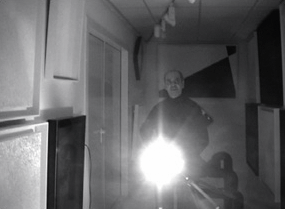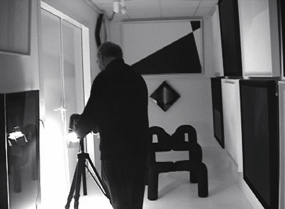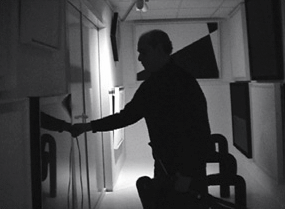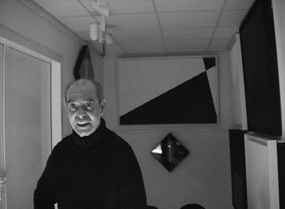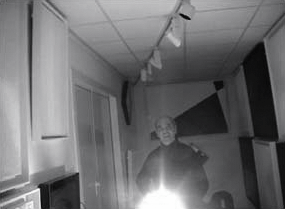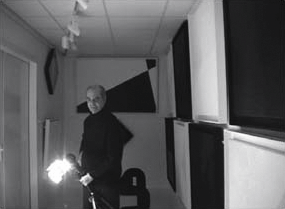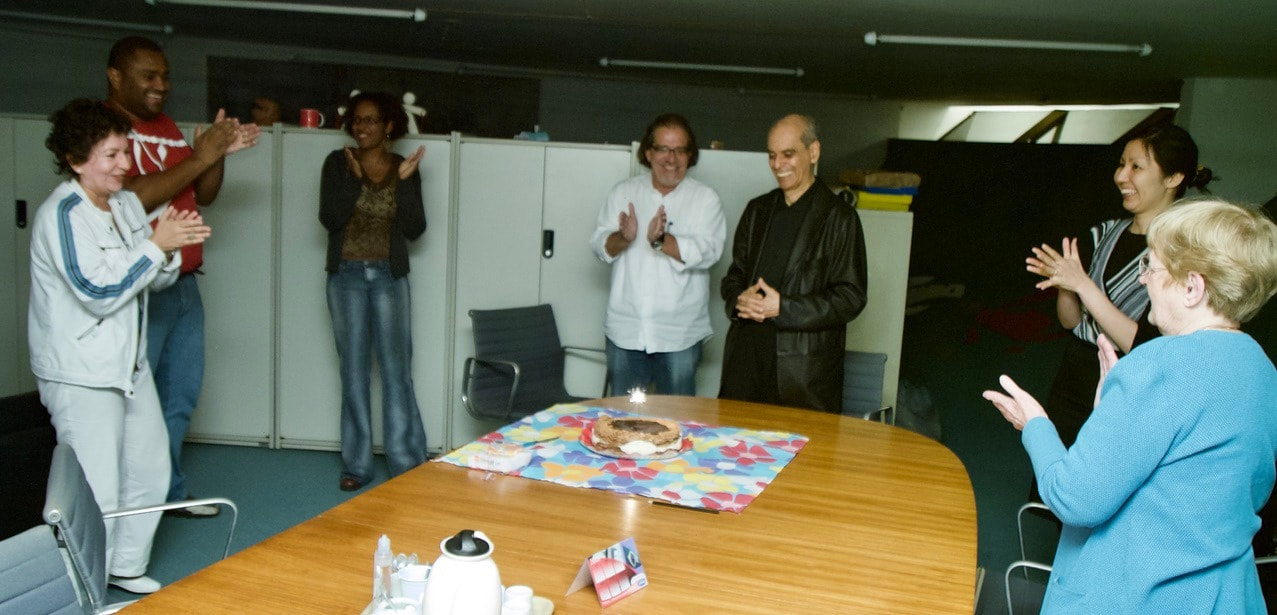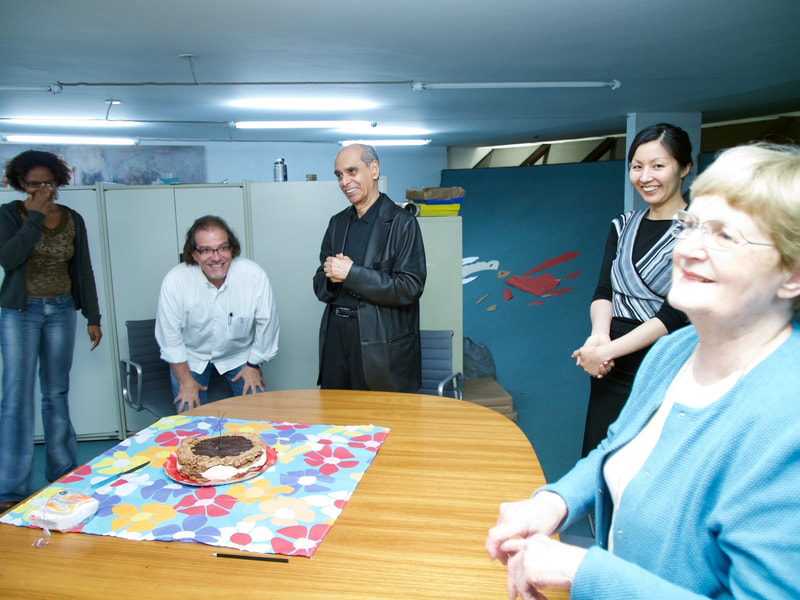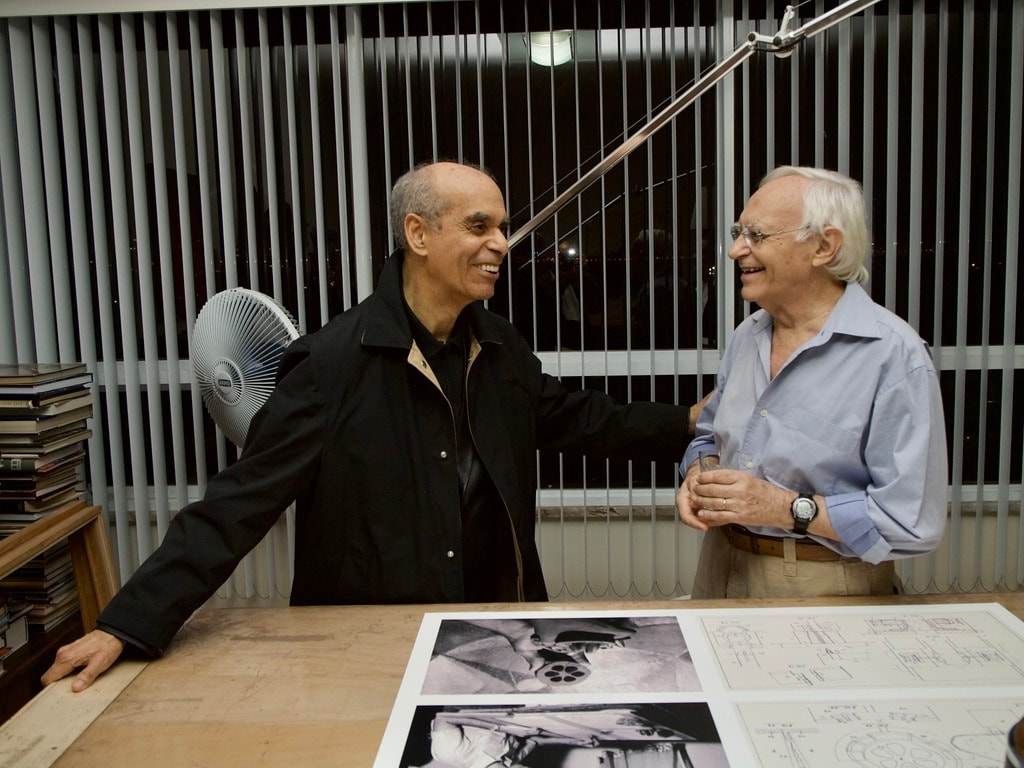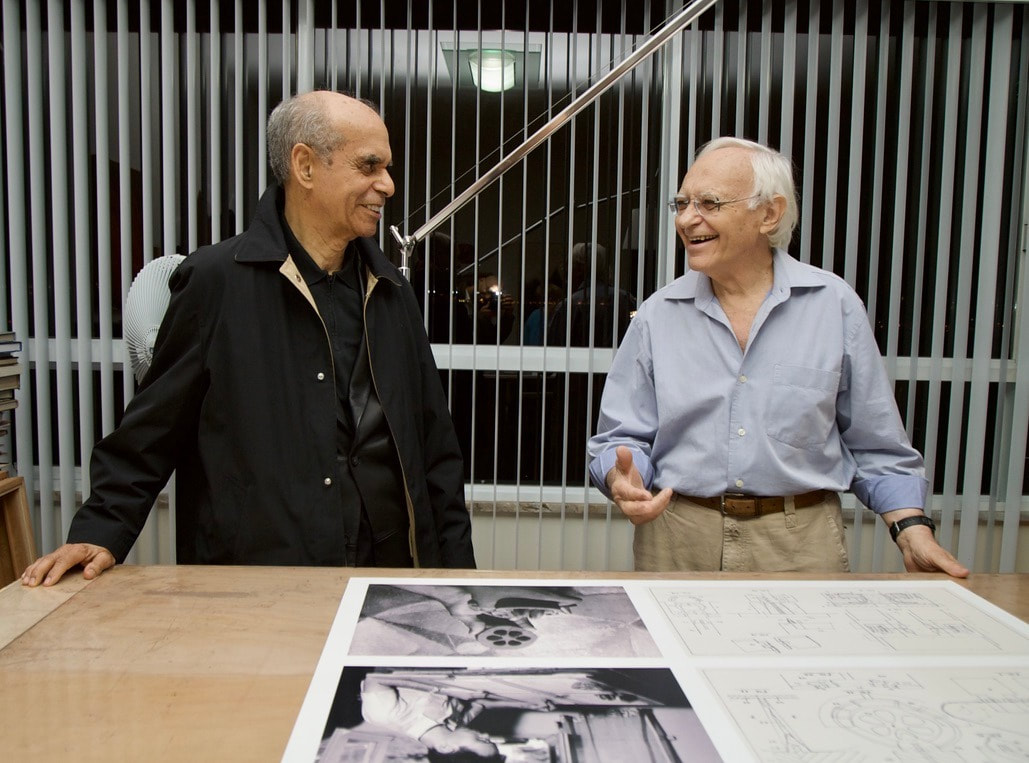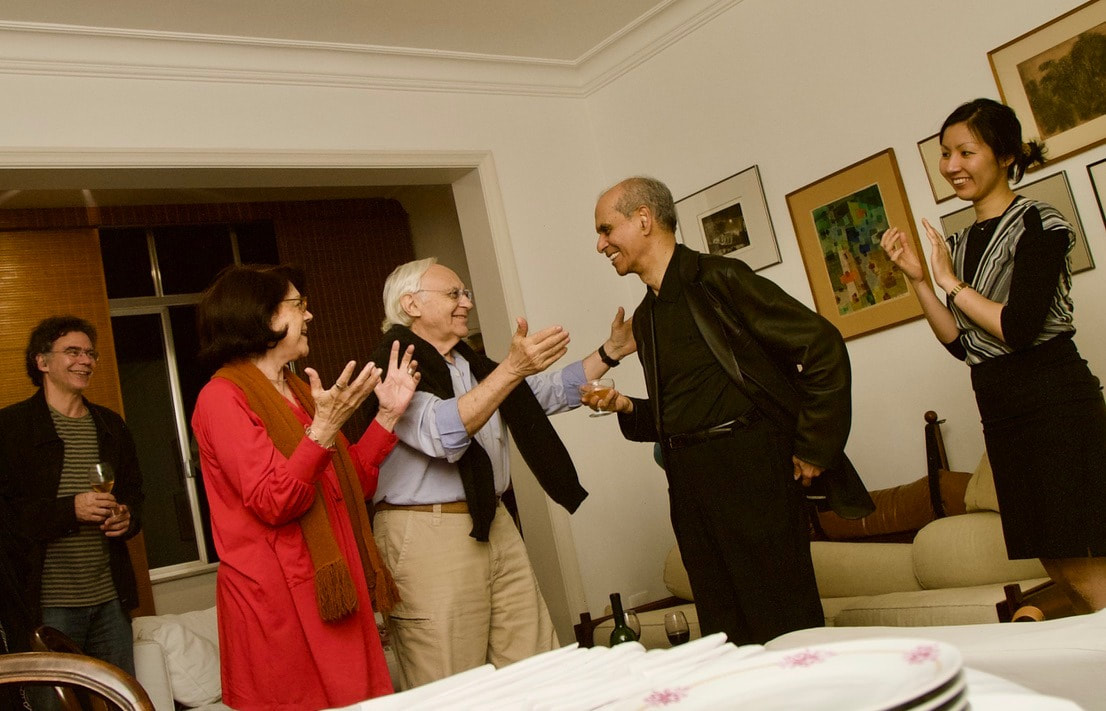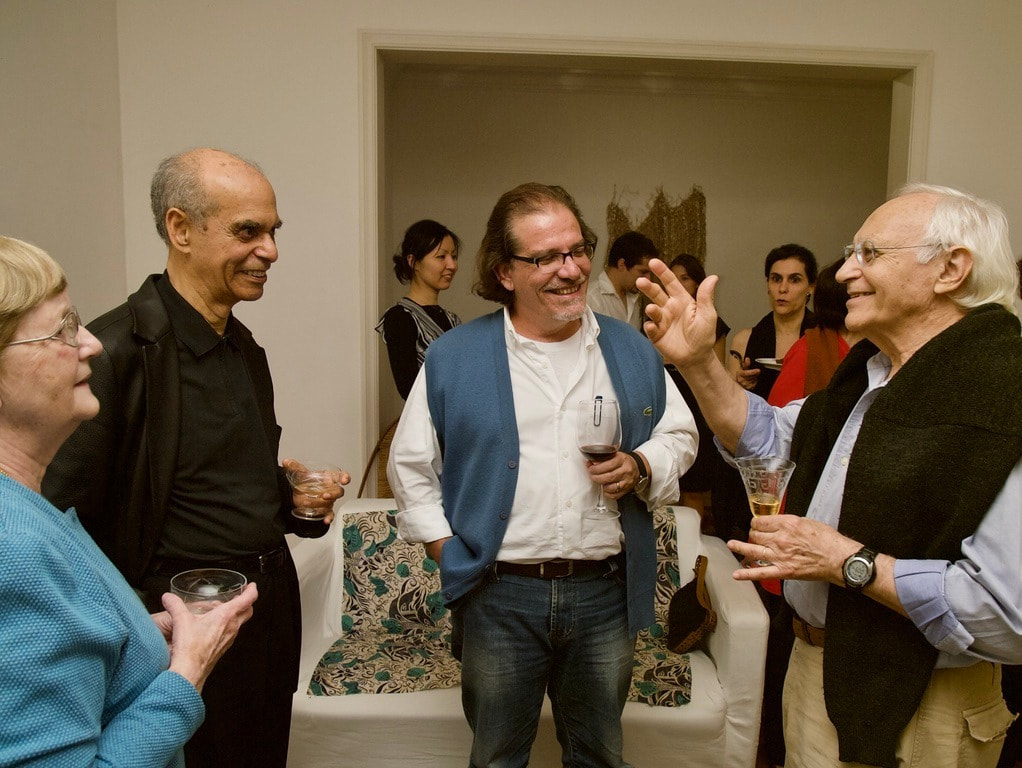|
|
momentos de luz/
|
flavio cohnflavio and peter cohn from dan galeria contacted almir in 2007 and flavio visited my father in hamburg. from then onwards a journey began with many visits, exhibitions, sales, beautiful dinners and a lasting friendship that feels like family. dan galeria reintroduced mavignier to brazil. here flavio cohn writing in the 2008 exhibition catalogue moments of light (momentos de luz).
|
|
The return of almir mavignier
for years, almir mavignier is a name that has inhabited my consciousness and one i have long nurtured the dream of inviting to hold an exhibition at dan galeria.
i was keen to go to hamburg to see first hand not just his works but the artist himself, and to have the chance to introduce myself and propose representing him in brazil. finally, in 2007, encouraged by talks with macaparana, i made my first telephone contact with almir mavignier and went to Hamburg. in recent years dan galeria has held exhibitions of some of the founding artists of the concrete and neoconcrete movements, such as luis sacilotto, lothar charoux, lygia clark, as well as international artists including sol lewitt, jesus rafael soto, césar paternosto and adolfo estrada, which was why we felt compelled to fill the crucial link that was missing in brazilian memory: almir mavignier. it was with this purpose that i went to hamburg. initially, it seemed to me that mavignier was unwilling to leave the peace and quiet of his richly fulfilled life in hamburg. why should he have to leave his comfort and return to his native land after having built up his career as an established artist held in esteem by international critics? why indeed? such was the topic of some days of conversations and visits to his studio, a treasure that is safeguarded and shielded from outside eyes. little by little, i realized that mavignier’s reserved demeanor had belied his recepti- veness to my ideas. i therefore suggested we break in our partnership by exhibiting his work at the spanish art fair arco 2008, the year in which it was paying special tribute to brazil. mavignier accepted. madrid, arco 2008
in madrid, mavignier’s work was an outright success, admired by german, british and american gallery owners and by the brazi- lians who visited the stand, as well as cura- tors and collectors. the response was so positive that mavignier was eventually convinced that it was time he returned home, for:
for everything he has done, almir mavignier’s importance transcends his work in the fine arts and design. his wisdom and generosity take him beyond frontiers. a man of light, his life mirrors his work, his painting revealing in our eyes what our unconscious already knows and what our consciousness queries or questions. mavignier came to rio de janeiro in april of this year to take part in the opening of the poets of color exhibition at mac de niterói, organized by luiz guilherme vergara, after which he traveled on to são paulo to see dan galeria. in june of this year i returned to hamburg to revisit mavignier and his works and also to settle what would be included in this exhi- bition. we reached the conclusion that it would be an opportune moment to present the set of previously unseen works in monochrome black and white that mavignier has called “moments of light”. in these works, mavignier transformes color matter into pictorial light. Flavio cohn, 2008 o retorno de mavignier
durante anos o nome almir mavignier esteve presente em minha memória e alimentei o sonho de convidá-lo a realizar uma exposição de suas obras na dan galeria.
estava ansioso por visitá-lo em hamburgo, para ver pessoalmente não só suas obras, mas o próprio artista, para assim poder me apresentar e propor-lhe uma representação no brasil. finalmente em 2007, estimulado pelas conversas com macaparana, fiz contato pela primeira vez por telefone com almir mavignier e fui a hamburgo. como a dan galeria realizou nos últimos anos exposições de artistas que foram fundadores dos movimentos concretista e neoconcretista como: luis sacilotto, lothar charoux, lygia clark e exposições de artistas internacionais como: sol lewitt, jesus rafael soto, césar paternosto e adolfo estrada, tínhamos que resgatar o elo fundamental, esquecido pelo brasil: almir mavignier. com este objetivo cheguei à hamburgo. num primeiro momento percebi que mavignier estava reticente com minha idéia de tirá-lo do sossego de sua vida plena e realizada em hamburgo. provocá-lo a sair de seu conforto para trazê-lo de volta ao seu país, depois de ter construído a carreira como artista realizado e consagrado pela critica internacional, para que? por que? este foi o tema de alguns dias de conversas e visitas ao seu atelier, um tesouro guardado e distante dos nossos olhos. aos poucos senti que mavignier, apesar de sua atitude reservada, havia me recebido com uma abertura positiva. propus iniciarmos nossa parceria, expondo suas obras na feira espanhola “arco’08”, no ano em que o brasil foi o país homenageado. mavignier aceitou. madri arco 2008
em madri, a obra de mavignier fez um sucesso absoluto. apreciada por galeristas alemães, ingleses, americanos e pelos brasileiros que visitaram o stand, curadores e colecionadores. a receptividade foi tão positiva que mavignier acabou convencendo-se de que havia chegado a hora de retornar a sua casa, pois:
por tudo o que fez, a importância de almir mavignier já transcende sua obra como artista plástico e artista gráfico. sua sabedoria e generosidade fizeram-no ultrapassar fronteiras. homem-luz, sua vida espelha a sua obra, sua pintura revela aos nossos olhos o que nosso inconsciente já sabe e nossa consciência duvida ou questiona. mavignier veio ao rio de janeiro em abril deste ano, para participar da abertura da exposição “poetas da cor” no mac niterói, organizada por luiz guilherme vergara e estendeu sua viajem até são paulo, para conhecer a dan galeria. em junho deste ano retornei a hamburgo para reencontrar mavignier e suas obras, e também para definirmos quais fariam parte desta exposição. chegamos à conclusão de que seria o momento oportuno para apresentarmos o conjunto de obras inéditas, monocromáticas brancas e pretas, nomeadas por mavignier como “momentos de luz”. neste conjunto de obras, mavignier transmuta a matéria cromática em luz pictórica. flavio cohn, 2008 |
momentos de luz
|
mac 2007
|
|
here vergara's account and memories from the visit and collaboration with almir, also published in the dan galeria catalogue moments of light (momentos de luz, 2008)
|
|
exposição almir mavignier
com muita alegria e entusiasmo recebi o convite (e desafio) de mavignier para apresentar esta mostra. desafio pela indagação que acompanha esse título iluminado: momentos de luz. indagação: a cor não tem forma. a forma não tem cor. como libertar a cor da forma? ...pela luz, pela estrutura... após longas conversas pelo telefone conseguimos realizar um sonho de 2005, mesmo que parcialmente, e trouxemos este ano o mavignier para ser um dos poetas da cor em exposição do mac de niterói. foram dias maravilhosos de convívio, cafés acompanhados de longas viagens no tempo, muitas memórias, infinitas aulas de vida e de arte – sem dúvida, momentos de luz. ao me chamar para compor este texto, mavignier mais uma vez me surpreendeu. desta vez, foi ele quem propôs o nome da mostra – momentos de luz. que nome inspirado! esta apresentação toma como foco a abrangência de sentidos – momentos de luz – que marcou o meu encontro com os mavignier em hamburgo, no inverno de 2005. o entrelaçamento entre arte e vida faz o contraponto desta apresentação, a comunhão com o mundo do artista, o inverno em hamburgo, sua casa, sua família e seu atelier, assim como a imersão na luz das idéias que envolvem esta instigante série de telas brancas e pretas na indagação intuitiva: a libertação da cor da forma! nessa arqueologia da criação de mavignier, reúnem-se camadas de conspirações e articulações em intertextos2 que atravessam ou transbordam o mundo das idéias puras do artista para os momentos compartilhados de iluminação para além da arte concreta. esta série de momentos de luz sugere uma experiência culminante de um pensar sistêmico de mavignier. torna visível a paradoxal pureza da arte, quando atinge o “nadaconcreto”, tocando também os limites da física para a metafísica da cor na direção de uma fenomenologia do instante-tempoluz, pois demanda o momento de encontro de um observador com a obra. cada obra não é mais uma tela ou objeto, mas sistema de sistemas onde são projetadas rotações de centros e estruturas centrípetas e centrífugas formando campos gravitacionais reversíveis entre macro e microcosmo. surgem para este observador atento sistemas de geometrias complexas imaginárias, sem dúvida não-euclidianas, que cortam um quadrado por eixos paragonais (termo de sua autoria) e diagonais, dentro de uma precisão cósmica de movimentos que sugerem altíssimas velocidades. mavignier vislumbra e oferece a esse espectador o nascer de pontos, superfícies, estruturas e formas em movimentos, como para um cientista a descoberta da consciência do átomo se aproxima da astroquímica. mavignier inaugura geometrias de transformações, como um pintor metafísico que realiza meta-esquemas2 de universos em revolução, vórtex de luz que acelera partículas intangíveis liberando a cor-luz da forma. o artista iluminado da arte concreta agora se (des)dobra para uma possível dimensão metaconcreta da arte. é possível libertar a cor da forma! – a resposta emerge por uma dimensão fenomenológica da experiência estética, quando se dá a convergência entre consciência poética e quântica no instante-tempo da luz, a matéria artística se realiza como momento de iluminação – ou pensamento forma! sem perder a poesia, ao artista cabe a responsabilidade de elevar a “arte-consciência ao horizonte-limite do provável” para o macro como para o microcosmo. os jogos de dados da poesia de mallarmé se avizinham da poética das rotações do quadrado cósmico de mavignier. lembrando haroldo de campos, mavignier conquista a prova, provoca a forma para a sua fusão e fissão nuclear: o seu horizonte é um quadrado que se torna infinito pela luz. ao mesmo tempo, excita a cor ao máximo para o seu instante-espaço temporal que se inaugura com a aproximação de cada olhar. jogam-se novos dados para cada observador – onde o preto se torna o infinito máximo de transcendência ou profundidade e o branco, de imanência-ternura. acasos determinados! assim mavignier gosta de jogar com os opostos, a vizinhança e vigilância de contradições que se alternam: certeza – arte concreta; incertezas – arte metaconcreta. (1) exposição poetas da cor. mac de niterói, 2008 2 meta-esquema – o termo intitula uma série de obras do helio oiticica, do final dos anos 50, que também potencializam uma dimensão dinâmica tencionando os eixos de percepção gestalticos. porém, mavignier eleva essa tensão ao limite em que a cor se desprende da forma, pela luz e pelo movimento. momento de luz I
acaso x determinado tempestade de neve x cubo branco
em janeiro de 2005 tive a oportunidade de visitar almir mavignier em hamburgo. para nós brasileiros, habitantes deste país de verdes permanentes, a paisagem do inverno europeu, quando dominada pelo branco da neve, causa um imenso impacto de encan- tamento ou estranhamento. a cobertura branca da neve exerce uma mágica inter- venção sobre a realidade cotidiana, o mundo colorido se transfigura pelo apagamento das cores das formas. invasões de branco reduzem a paisagem à marcas e manchas gráficas das linhas pretas dos prédios, pos- tes e sinalizações, contrastando com os movimentos dos carros e pessoas. recordo daquele inverno cercado de branco e de frio, sendo carinhosamente acolhido pelo casal mavignier, que me conduziu a um peque- no apartamento para o meu pernoite. ainda tenho vivas as impressões de surpresa ao entrar naquele ambiente cuidadosamen- te branco – piso, móveis e paredes – onde a leveza atingia grau de uma quase imate- rialidade – um estado poético fora da arte concreta. essas memórias se entrelaçam com as sensações de inverno da longa via- gem – londres – hamburgo –, dos horizontes além daquele pequeno cubo branco, jun- tamente com as longas conversas com os mavigniers. ao re-visitar essas lembranças justapondo mundos paralelos com as aspi- rações artísticas de mavignier, com a sua maneira de jogar com os opostos – acaso e determinado, arte e existência, conscien- te e inconsciente –, apontam-se amplitudes existenciais para os momentos de luz em hamburgo, em que por pequenas frestas se revela a potência desse grande mestre da arte concreta brasileira.
assim, vale incluir as notas sobre aque- le inverno branco e preto em hamburgo como acasos determinados entre mun- dos paralelos da arte e da existência. o poder das tempestades de neve passa a fazer parte das imagens que compõem os momentos e jogos de luz nas múltiplas leituras sobre a série de pinturas brancas e pretas de mavignier. para fora da janela de seu atelier, a paisagem estava coberta por massas de neve. as formas e constru- ções que demarcam as escrituras e ruídos do mundo estavam apagadas e silenciadas pelos transbordamentos brancos, reme- tendo também às relações entre escrita e vazio. um outro simbolismo que aquela pai- sagem de neve traz ao ampliar a moldura das pinturas branco e preto de mavignier é o das relações entre o “fogo branco”(3) e o fogo preto, da presença semântica dos espaços entre linhas, onde se manifesta o silêncio entre fala e comunicação – o dito e o intuído –, a forma e a expressão. o outro do homem, segundo esta abordagem de doctors, é o vazio entre as letras, o que realmente nos permite ler. e continua doc- tors, com a profecia sobre as leituras entre o fogo branco e o fogo preto: a parábola da palavra conclui que a humanidade, por enquanto, só sabe ler o fogo negro. haverá um dia em que seremos capazes de ler o fogo branco. esse paradoxo é o nosso desejo, e o papel é a possibilidade metafórica desse paradoxo.” momento de luz II
ritual de transfiguração da arte concreta em metaconcreta
mavignier começa sua apresentação ligando um pequeno holofote na tomada. a sala toda branca passava a ser iluminada pelo artista em movimento, ao mesmo tempo em que ele indicava com a luz cada obra que comentava. movia o foco de luz enquanto explorava relações mutantes entre os detalhes e o todo – multiplicação de rotações para além da tela – da luz. começou com uma grande pintura formada por dois grandes triângulos pretos sobre fundo branco, que formam um campo de tensão no ponto de encontro entre dois vértices que “quase se tocam”, milimetricamente calculado. com a composição de uma dinâmica impactante – por formas geométricas – mavignier expressa uma poética concreta para um drama sublime. o ponto como entidade se manifesta pela ausência – pela abstração que induz a sua existência. esse primeiro grande quadro, chamado o ponto, é apresentado por mavignier como “único quadro com o ‘ponto’ (nesta série), porque não é possível tocar o ponto, da mesma forma essas duas formas não se tocam – ali no espaço onde elas não se tocam se realiza a abstração do ponto”. encontram-se duas montanhas triangulares que se contrapõem como dois grandes vetores: o primeiro se ergue pela diagonal ascendente da esquerda para a direita; o outro, menor, penetra na tela pela mesma diagonal, apontando para baixo na direção do seu contraponto. são dois grandes triângulos opostos pelos vértices, quase se tocando. porém, com uma precisão renascentista, os dois vértices não se tocam – deixando para esse espaço infinitesimal a indução de um ponto e uma (in) certeza, como momento de grande atração ou confronto. a cena de encontro ou tensão de formas triangulares conduz a um jogo de movimentos e contrastes extremos, do preto sobre o branco, de forças ascendentes com seu rebatimento descendente, inaugurando também reflexões que vão além da arte concreta – lembrando uma versão minimalista para o ponto de atração e separação da criação e criador de miguelangelo na capela sistina. porém, mavignier traz a concretude do ponto pela imaterialidade do espaço que se torna tempo-instante daquilo que ainda não é tocado, ou está por ser tocado, um minúsculo branco de luzmomento que incorpora para o observador a consciência do átomo. mavignier segue para um outro conjunto de telas que tratam da sua indagação sobre a libertação entre cor e forma – série que explora a forma “tetrágonos”. pela rotação imaginária de estruturas no espaço, a partir de um quadrado ideal, mavignier promove deformações e mutações gerando variados tetrágonos. essas telas quadradas monocromáticas se tornam campos de rebatimentos de movimentos de estruturas no espaço articuladas por centros de rotações fixos. nesses jogos de movimentos e contramovimentos (termo também usado por paul klee) plásticos, mavignier, como um cientista da física na arte, leva a experiência estética ao limite de libertação da cor da forma e matéria, como dimensões ou gravitações da luz. com o título, ou conceito, “momento de luz”, mavignier invoca para a experiência da luz ou da arte sua unidade indissociável no tempo – trazendo os problemas da essência ou genealogia da pintura para a interação perceptiva do espectador. em outras palavras, o artista trabalha e cria dentro de um laboratório de percepções, pois é no campo da fenomenologia que se realiza paradoxalmente a liberdade e a ligação entre cor e forma, assim como entre consciência e percepção. “é possível libertar a cor da forma” – mavignier comenta ao mesmo tempo em que move o holofote em diferentes ângulos da tela. “se você ilumina frontalmente, a forma desaparece, se você dá uma iluminação lateral, a forma reaparece. a cor se liberta da forma pela estrutura, pela luz.” estrutura, segundo mavignier, é a topologia criada por diferentes texturas na tela pintada. a luz em movimento gera diferentes sombras e cores, ou o espectador em movimento. o quadro é uma fonte da percepção. ao contrário de albers, mavignier eleva o quadrado a uma condição dinâmica de rotações que são projetadas como tetragons, ou uma geometria de transformações também conhecida como não-euclidianas. a forma que se organiza apenas pela textura aparece e desaparece dentro do monocromático quadrado branco, como na outra tela, preta. não é mais malevich, exclama mavignier. a forma sobre a tela quadrada branca responde à incidência da luz, aparecendo e desaparecendo. além disso, esse quadrado deformado sugere o rebatimento ou sombra de uma outra forma projetada que se move no espaço tridimensional fora da tela. é a visão não-euclidiana de uma geometria de transformações que se apresenta nos experimentos de mavignier compondo uma série de monocromáticos brancos e pretos de instante de suspensão de momento/movimento de um quadrado no espaço quando se quebram as leis de paralelismo. nesta geometria de rotações de estruturas no espaço, mavignier leva também a matéria da arte a sua potência-limite como luz-tempo, da mesma forma pela consciência estética relacional do observador – esta se expande como conquista de uma idéia, lembrando ou superando seu aprendizado da escola de ulm. sua precisão engloba o seu contraponto, o campo da transcendência (fogo branco) – deslumbramento e devir do que ainda não está consciente pelo próprio artista, mas já é determinado. MOMENTO DE LUZ III
A CULMINÂNCIA NO NADA CONCRETO um sopro:
there is a crack in everything that’s how the light gets in.” acaso e precisão, projeto e experimentação determinada parecem compor a arqueologia da criação de mavignier. tudo acontece em torno de um artista que entende a sua obra como um laboratório de percepções, onde um ritual especial de iniciação de um olhar móvel introduz em cada nova série uma ótica perceptiva relacional. a experiência de cada obra é contada pelo artista: ressaltam-se momentos de mutação entre o ponto de vista do espectador e o quadro, mas também dentro de cada tela, um sistema de estruturas, ponto e contraponto, movimento e contramovimento compõem uma poética da matéria lúcida. nessa investigação relacional as questões da arte concreta são ultrapassadas pela sua dimensão metaconcreta, por uma geometria de transformações, campos de projeções e convergências de movimentos que solicitam do observador uma condição de visão em movimento (para se utilizar o termo de moholy-nagi: vision in motion). as telas de forma quadrada servem também para tensionar o estático da moldura e os sistemas de estruturas em movimentos, como centros gravitacionais de movimentos de estruturas e formas que ultrapassam a moldura da tela. mavignier conquista o espaço pela luz-tempo, por dinâmicas de movimentos que se compõem também com a visão in motion do espectador. os experimentos de moholy-nagi culminaram com os moduladores luz-espaço, máquinas tão emblemáticas para as vanguardas dada e cubistas que penetraram nas pesquisas da bauhaus. a arte cinética dessa geração transitava entre as descobertas da física – da teoria da relatividade – por investigações que lançavam mão da produção de máquinas estéticas produzindo poéticas da luz, óticas perceptivas cinéticas. movimentos de rotação de luz, forma e planos eram materializados pelas projeções dessas máquinas. mavignier mergulha também no campo de luz-espaço e movimento pelos instrumentos da pintura que o levam a uma imersão e à descoberta de fronteiras entre visões internas de movimentos de planos, estruturas de luz que nascem no campo mental.
ao acaso, para além desse laboratório de percepções, o inverno cobria de branco o silêncio da cidade de hamburgo. essas lembranças compõem este ensaio que parte de uma idéia central que acompanha mavignier há muitos anos. em 2005, antes de nossa ida ao seu atelier, mavignier introduzia a mesma questão que agora se torna o foco dessa mostra: “é possível libertar a forma da cor? sim, é possível.” no dia seguinte, ele retomou essas indagações ao me introduzir ao seu santuário – altar –, um ambiente anexo ao atelier, onde se instala sua série branco e preto. uma sinfonia que tomaria a liberdade de chamar de “cósmica”. um pequeno cubo branco, cuidadosamente planejado, com uma cadeira preta ao centro, para abrigar suas variações e estudos da luz-forma. a cor não tem forma utilizando-se de um refletor de luz, pequeno porém de alta potência, mavignier deslocava o ângulo de incidência sobre uma pintura de um quadrilátero branco sobre uma superfície branca, um quadrado deformado produzido apenas pela variação de texturas de uma mesma cor. junto a essa pintura estava uma versão da mesma estrutura – forma em preto. de acordo com a posição do spot de luz na sua mão, mavignier fazia aparecer e desaparecer a forma, libertando a cor da forma, ou a forma da cor. é possível! a fonte de luz “em movimento” liberta a cor da forma. ao rever essas cenas registradas em vídeo, pude melhor perceber a dimensão fenomenológica desse jogo entre cor, forma, luz e estrutura, como também a abrangência do título momentos de luz. sendo a fonte de luz projetada móvel, o artista pesquisador ressalta ao longo do tempo-ação diferentes leituras e percepções da mesma estrutura pelo movimento do observador; de acordo com esse jogo de luz, mavignier faz se dissolverem ou ressaltarem relações aparentemente fixas entre forma, cor e estrutura para um leitor móvel. tudo se dissolvia ao colocar frontalmente o foco de luz, para ressurgirem arestas e ângulos de diferentes texturas quando a mesma luz varria diagonalmente a tela.
nessa experimentação dinâmica, os momentos de luz se fundiam à performance de mavignier. como um físico, o artista pesquisador quebra as barreiras da pintura, inclusive da geometria euclidiana, como também da reversibilidade relacional entre cor e forma. as relações tradicionais e estáticas entre sujeito e objeto na pintura são arrebatadas pelos limites de uma gestaltung expandida, onde uma obra não mais representa uma única totalidade – figura e fundo – mas um sistema de sistemas – matéria, forma, estrutura se tornam campos dinâmicos que dançam conforme a luz, conforme o observador. uma verdadeira teoria sistêmica se desdobra pela fenomenologia dessa experiência de campos perceptivos relacionais. o artista pesquisador assim como o espectador se tornam também parte desse momento de criação – cúmplices dos limites da matéria lúcida na pintura. na explosão da luz sobre cada tela, o artista ia descrevendo sua própria arqueologia da criação. ali no atelier em hamburgo de mavignier, um iniciado da escola de ulm, emblematicamente como uma caverna branca de luz, um platão invertido, projetavam-se profundidades luminosas em cada parede, em cada tela, revelando-se uma outra dimensão para o significado e amplitude do chamado “momento de luz”, a revelação de sistemas relacionais de percepções – de encontros e movimentos múltiplos do artista-criador, com cada observador, com o seu jogo de luz –, sombra e mais luz. a gestalt atingida – totalidade – é criação, é momento de luz. aquele momento de luz poderia se comparar ao instante inspirado de paul klee, em diários: agora largo o trabalho, deixo-o de lado. algo atravessa-me tão profunda e tão docemente – sinto isto e, sem nenhuma aplicação, torno-me absolutamente certo, seguro. a cor me tem. não preciso mais correr pressuroso atrás dela. gilvan fogel(5) se utiliza desse trecho de klee para explorar o fazer do silêncio. percorrendo cada ponto da afirmação de klee, gilvan explora as relações entre momento de realização, pintura como verbo e processo de vir a ser, coloração e coração. o artista como “homem de silêncio”6 é to- mado e toma sua vida pelo projeto-arte.
o homem que tem, o homem que é uma tal tarefa é ainda um homem de destino, de destinação própria, cheio de submissão e da coerção à necessidade – enfim, é um homem de silêncio... e de solidão.”(2) o que para klee significava pertencer à cor, para mavignier é ser tomado, é exercer a tarefa, ou exercício da luz. esta é a visão clara que se costura por toda a vida e destino desse artista encapsulado naquele momento. destino e acaso se entrelaçam na vida de mavignier como jogos de gestalts – figura e fundo, branco e preto. quantas horas de solidão e silêncio não estavam ali acumuladas, de mergulhos em si mesmo, na busca de momentos de iluminação para tantas indagações. e parte dessa experiência culminante de uma vida artística iniciada em ingenium de dentro, estava também presente na soma de todas as cores luzes em pura luz branca – ou pela mistura de todas as tintas, como preto na pintura; das cavernas dos ambulatórios do hospital pedro II a ulm, agora em hamburg (2005), amanhã em são paulo, 2008. nesta sala se experimenta por um estado liminal um ideal de merleau-ponty, um laboratório da fenomenologia da percepção. mavignier pinta a redução máxima, assim como a síntese das sínteses: a luz branca como equivalente à adição total; o preto representando a subtração-limite da luz, na sua gravidade máxima. dois estados opostos convergem: a máxima gravitação da luz, onde a cor se restringe à gravidade da luz, ao mesmo tempo em que atinge a extrema leveza da matéria lúcida. a pintura é silêncio e sinfonia, onde a figura se projeta pela negritude ao vazio pleno; o fundo por sua vez transborda como fogo branco. sim, é possível o encontro de paradoxos – coincidatio oppositorum –, assim cria mavignier: afirma o ponto pelo vazio, reconhece a sua intangibilidade física, mas não estética. o artista torna visível o vazio, o infinito e o nada, pelo esforço mental da busca incansável para expressar uma idéia, uma abstração. por quantos anos mavignier atraiu ou construiu relações de subversão entre opostos: começando pelos artistas não-artistas do engenho de dentro. a forma se descola da cor, a cor se liberta pela luz. a loucura libera imagens, as imagens liberam a loucura. imagens que não pertencem aos domínios das regras, da razão disciplinada, mas dos transbordamentos da luz pelas frestas dos aprisionamentos dos conceitos e tabus: “there is a crack in everything that’s how the light gets in.” / existe uma fresta em tudo, é por lá que a luz penetra. (leonard cohen) várias dobraduras da razão compõem os ricos aprendizados que emanam de mavignier e suas superações ou quebra de paradigmas. com freqüência mavignier cita as quinze variações que mário pedrosa, nos idos anos 50, apontou como chaves da arte concreta de max bill em são paulo. mavignier partiu da experiência do hospital no engenho de dentro, onde a criação artística consciente era ultrapassada pelo transbordamento inconsciente, e leva para paris e depois para a escola de ulm – esta bagagem de momentos de luz. o que já estava determinado e o que foi obra do acaso – estes são os paradoxos que mavignier costuma muito expressar, o quanto de futuro já estava determinado no engenho de dentro, “ingenio de dentro”, de um caminho de descobertas de si próprio. do fundo da escuridão e incerteza daquele hospital, as memórias ainda hoje são recontadas. desde lá, sem saber, mavignier já estava atuando como um portador de luz ou do “fogo branco”, subvertendo ordens entre a razão e o além da razão; entre consciente e o que ainda não está consciente – aceso. levar pacientes para o sol se ampliou para a condução de luzes de dentro para fora, abrindo visões/janelas interiores. das lições de ulm, da relação entre arte e a realização de uma idéia (que também pode ser chamada como momento de luz); arte e a tensão entre precisão e imprecisão; além de albers. naquela ocasião pude ter a experiência inesquecível de mergulhar por dois dias contínuos no presente, passado e futuro do grande artista – pesquisas sobre cor, forma e luz que foram conduzidas impecavelmente durante décadas. sim, naquela visita foi possível entender o que ele quis dizer quando afirmou que “o futuro de cada pintor está dentro de sua obra”. lá, então, ao longo daquelas horas em seu atelier, no ritual do artista de tirar de cada uma de suas grandes gavetas seus tesouros de luz – foto e grafias em posters –, já poderia ser apontado, por diferentes ângulos, o futuro daquele encontro que hoje é relembrado como “momento de luz”. cor é luz!, afirma mavignier como síntese que se une com o tempo-instante de um observador móvel provocado por momentos de luz a uma atitude perceptiva dentro de um campo de mutações cromáticas em cada obra desta mostra. na exaltação da libertação da cor como qualidade da luz pela percepção e imaginação que o artista oferece ao espectador, mavignier intui um caminho para o primado da percepção, uma fenomenologia da consciência que liberta a luz do átomo, a cor da forma. toda a sua invenção da cor-forma em movimentos relacionais é uma celebração da vida, da totalidade visível através de momentos de espaço-luz. visitar esta mostra é absorver porções de luz através da arte, ou seja, ser iluminado pelo que forma e se alimenta de luz em nossos olhos, mais ainda, do que se inaugura pela visão interna em cada obra pelo artista. mavignier rege e é regido por uma sinfonia de cor-luz do ‘in’-visível (visível de dentro) para ser visível em e por movimentos. pois, diante de suas obras, não se experimentam apenas a luz-cor e forma como fenômenos isolados do observador, mas a sinergia destes como sistemas de ordens e novas ordens em interações indissociáveis do espaçotempo de cada observador. estas são as ações e paixões pela luz que comandam a razão poética de mavignier. não há dúvida: para enxergar a luz é preciso tomar e ser tomado pela presença ou regência de um olhar iluminado (da luz que modela o olho), o mesmo que mavignier nos empresta, tornando visível o fenômeno mágico da origem e das mutações contínuas entre luz, cor e forma na matéria da arte, como transcendência e imanência da vida na arte e da arte na vida. (5) fogel, gilvan. “a respeito do fazer necessário e inútil ou silêncio”. in: fogel, gilvan, ruin, hans. schuback, márcia sá cavalcante. por uma fenomenologia do silêncio. rio de janeiro: sette letras, ufrj, 1996. Exposition almir mavignier
moments of light it was with great joy and enthusiasm that i took up mavignier’s invitation (and chal- lenge) to introduce his exhibition. a challenge because of the question that accompanies this illuminated title: moments of light. ques- tion: color has no form. form has no color. how can color be released from form? ... through light, through structure... after many telephone conversations, we managed to turn a dream from 2005 into reality, albeit partially, when we brought mavignier’s work to mac de niterói this year as one of the poets of color in the exhibition of the same name. many wonderful days together ensued: journeys down memory lane over cups of coffee, countless remi- niscences, endless lessons in life and art – unquestionably, moments of light. when i was invited to write this text, mavignier sur- prised me once again. this time, it was he who proposed the title: moments of light. what an inspired name! this introduction is organized around the breadth of mean- ings – moments of light – that involved my encounter with the mavigniers in hamburg in the winter of 2005. the intermingling of art and life provides a counterpoint for this introduction, the communion with the art- ist’s world, the hamburg winter, his home, family and studio, and the immersion in the light of the ideas that envelop this thought- provoking series of black and white can- vasses with an intuitive inquiry: the release of color from form! in this archaeological study of mavignier’s creative process, lay- ers of conspiracies and articulations come together in intertexts that cross or overflow from the world of the artist’s pure ideas to shared moments of illumination beyond concrete art. this series of moments of light would appear to be the culmination of a systematic thought process developed by mavignier. it unveils the paradoxical purity of art when it becomes “not-concrete”, while also touch- ing on the frontier between the physics and metaphysics of light, reaching towards a phenomenology of the light time-moment, which requires a moment of encounter between observer and work. each work is no longer a canvas or object, but a system of systems upon which rotations of cen- ters and centripetal and centrifugal struc- tures are projected, forming gravitational fields that are interchangeable between the macro and microcosm. to the mind of this watchful observer, it suggests systems of imaginary, complex, undoubtedly non- euclidean geometries, which cut a square with paragonal (his own term) and diagonal axes, within a cosmic precision of move- ments that suggest extremely high speeds. to this spectator, mavignier envisages and offers the source of points, surfaces, struc- tures and forms in movement, just as for a scientist the discovery of the consciousness of atoms is related to astrochemistry. mavi- gnier creates new geometries of transfor- mation, like a metaphysical painter creating meta-schemes2 of universes in revolution, vortexes of light that accelerate intangible particles, releasing light-color from form. bathed in concrete art, the artist now turns (in)to a new potential meta-concrete dimen- sion of art. it is possible to release color from form! – the answer emerges from a phenomeno- logical dimension of aesthetic experience: when poetic and quantum consciousness meet in the light time-moment, artistic material takes shape as a moment of illumi- nation – or form thought! without sacrificing poetry, the artist is responsible for raising “art-consciousness to the extreme horizon of probability” to the macro and microcosm. the rolls of the dice in mallarmé’s verse have much to do with the poetry in the rota- tions of mavignier’s cosmic squares. bring- ing haroldo de campos to mind, mavignier gets his proof and pushes the form to its nuclear fusion and fission. his horizon is a (1) poets of colour exhibition. mac de niterói, 2008 (2) metaesquema [metascheme] – title given to a series of works by helio oiticica from the late 1950s, which also empower a dynamic dimension by stretching the axes of gestalt perception. however, mavignier raises this tension to the point that color breaks free of form, light and movement. square that is made infinite by light. mean- while, he excites color to the extreme for his time space-moment, which appears afresh with each new look. a new roll of the dice for each observer, with black as the ultimate infinity of transcendence or depth, and white as tenderness-immanence. predetermined chance! such is mavignier’s way of tinker- ing with opposites, with the proximity and perceptiveness of alternating contradic- tions: certainty – concrete art; uncertainty – metaconcrete art. moment of light I
– chance vs. predetermination: snowstorm vs. white cube in january 2005, i went to visit almir mavignier in hamburg. to us brazilians, inhabitants of a country of permanent greens, the winter landscape in europe, when enveloped by the white of snow, strikes us as either enchanting or uncanny. the white blanket of snow intervenes magically over daily reality and the multicolored world is transformed as the colors of forms are muted. flurries of white reduce the black lines of buildings, posts and signposts to smudges and marks, in contrast with the movement of cars and people. in the midst of that winter, surrounded by cold and white, i remember being kindly taken in by the mavigniers, who took me to a small apartment to stay the night. i still vividly recall how surprised i felt when i entered that spotless white environment – floors, furniture and walls – where lightness was almost raised to a level of immateriality – a poetic state beyond concrete art. these memories mingle with the impact of winter after a long journey – london / hamburg – the horizons outside that small white cube, and the long conversations with the mavigniers. as i recall these memories, juxtaposing parallel worlds with mavignier’s artistic aspirations and his way of playing off opposites – chance and predetermination, art and existence, conscious and unconscious – an existential breadth for the moments of light in hamburg comes to mind, showing glimpses of the power of this great master of brazilian concrete art.
the notes taken during that black and white winter in hamburg are therefore worth including as elements of predetermined chance between the parallel worlds of art and existence. the power of the snowstorms became part of the images that made up the moments and plays of light for the multiple interpretations of the series of black and white paintings by mavignier. outside his studio window, the landscape was covered with piles of snow. the shapes and constructions that outlined the words and noises of the world were faded and muted by the sea of white, also bringing to mind the relationship between writing and void. another symbolism which that snowscape evoked by expanding the frame of mavignier’s black and white paintings was that of the relationship between “white fire”3 and black fire: the semantic presence of spaces between lines, where the silence between speech and communication is expressed, between the said and the inferred, form and expression. thus, mavignier’s poetry of light behaves like any speech or form, with white spaces, pregnant voids like musical silences between lines, white flames that carry utterances beyond the visible. mavignier’s paintings from this series must be approached not as objects, but as systems of syntheses, moments of consummation of white flames licking black flames, where concrete art even attains the fruition of the free light of form, becoming metaconcrete. this is how i came to see the paintings in my conversations with mavignier, in relationships that are growing to this day. the fascination with these moments of light is partly to do with getting to know mavignier as a narrator and protagonist of a story that goes beyond concrete art by discovering its existential ramifications, which run alongside or are inseparable from his biography. thus, the artist’s world interweaves with his output – an amplified gestalt of art and life. inquiries into the possible (in)dependence between color and form – by alterations to structure and light – are loosened from the canvasses in the studio and pass through windows, the landscape and the snow, while also crossing all the histories of art, colleagues and mentors from the luminescent legacy of mavignier’s conscious, not-yet-conscious and unconscious experience. as these notes on memory and experience overlap, every route taken becomes a moment of light: from the hospital in engenho de dentro, through the meetings with nise da silveira, mario pedrosa, palatnik and ivan serpa, to the artist’s final proximity to max bill through mary vieira, and the three months spent with albers, which last to this day. mavignier still recalls his first lesson with albers: “i didn’t come here to teach anything, but just to open your eyes”. and also the lesson on the point by paul klee, who inspired a broader understanding of art as concrete abstraction – the point as a present expression of the inexpressible, an idea without dimensions. while recounting these memories of encounters with mavignier, another archaeological study of his creation unearths, in layers, how this researcher artist has turned the lessons of his mentors into new subversions – new logical orders. thus, starting with klee’s tribute to the point, mavignier made a set of counterpoint experiments, putting the expression of empty space at the place where two straight lines meet. by exploring paradoxes, mavignier brings nothingness into the ultimate relationship between concrete art and abstract experience. likewise, albers’ squares of light have been instrumental in his new geometries beyond euclidean, geometries of transformation, geometries of shadows4 and rotations. by reducing the number of variables in his black and white monochromes, mavignier has envisaged compositions of intangible structural states, making visible the imaginary moment when color is released from form through light. works are born like stars, like solar systems, from rotating, translating structures. his joy is the outcome of a special wisdom, like the discovery of the consciousness of the atom – matter responds to light through art, without denying the artist’s hand. for everything is materialized through the alignment between ideas, consciousness and the hand. mavignier bears his lamp at the threshold between art and focused consciousness and casts light on his canvases, observing the behavior of the structures that are repeated in the white and black monochromes. the artist and scientist are immersed in the planetarium or studio-laboratory, watching as the canvases take on the dimensions of micro and macro gravitational fields – atomic and cosmic – imbued as they are with investigations into the behavior of particles that break up when they vibrate; or how color can be released from form. these are discoveries that derive from experience, and thus from a subject of the moments of light. thus, the problem of art/physics that mavignier explores does not fit into a positivistic scientific square, which is why it draws on a magical square of light that is projected from and into infinity. a gateway is offered to the observer, a pandora’s box, opening up on the instant of perception when color is released from form through moments of light.(3) the image of “white fire” comes from an inspired passage by marcio doctors, curator of fundação eva klabin rapaport, in the book a cultura do papel. “paper is actually man’s other. the materialization of a necessary space where man stores his dreams, his ideas, his experiences and his discoveries. linked to alphabetic script and technology (with the invention of movable type), paper, in the form of the book, has taken on a dimension that allows man to break free more fully from the immediacy of the world, launching into a world mediated by the crystallization of knowledge. this world is only inhabited by words, to the point that we forget that it is white – the empty page – that allows us to read. this reminds us of the cabalistic story of the two fires that created the divine scriptures. the black fire drew the letters, which we think we read, and the white fire drew the space between the letters, which allows us to read.” 4 geometry of shadows: the study of figures and their shadows in space, highlighting the properties of the figures that do not vary, through projection. also called transformation or projective geometry, where the properties of figures are observed which, sketched on a plane and projected onto another plane, vary according to the relationship with a projected point of light. the variations in the tetragons explored by mavignier could be addressed as projections of a square from one plane to another when these planes are not parallel, just as the source of light does not necessarily shine perpendicularly onto the planes of figures. during those special times in hamburg, all these routes and paradoxes of painting intermingled with mavignier’s concrete art or imaginary (or non-euclidean) geometry, suggesting that these light inventions have a metacroncrete dimension. interestingly, mavignier experimented with and explained his studies while holding a spotlight, moving the beam of light and further transforming the relationship between color-form and structure in his monochromes. looking back, these moments of play of light also prove the relationship between non-euclidean geometry and what could be called a geometry of transformations or of shadows. mavignier was breaking free of the parallels in euclidean geometry, while also transcending albers’ tribute to the square or the first signs of abstraction in the history of painting in malevich’s white square on white. a parábola da palavra conclui que a humanidade, por enquanto, só sabe ler o fogo negro. haverá um dia em que seremos capazes de ler o fogo branco. esse paradoxo é o nosso desejo, e o papel é a possibilidade metafórica desse paradoxo.” moment of light II
– ritual for transfiguring concrete art into metaconcrete art mavignier started his presentation by plugging in a small spotlight. the whole white room was now lit by the artist in movement as he pointed with the light to whichever work he was talking about. he moved the beam of light to explore the changing relationships between the details and the whole of the light – multiplying rotations beyond the canvas. he started with a large painting made up of two large black triangles on a white background, which form a field of tension at the point where two vertices “almost touch”, calculated down to the millimeter. in this composition of striking dynamics – using geometric forms – mavignier expresses a concrete poetic for a sublime drama. the point is an entity manifested through its absence – through the abstraction that induces its existence. this first large painting, called o ponto [the point], is presented by mavignier as the “only painting with the ‘point’ (in this series), because you can’t touch the point, just like these two forms don’t touch – there in the space where they don’t touch is the abstraction of the point.” two triangular mountains meet, offsetting each other like two great vectors: one rises diagonally from left to right; the other, smaller, penetrates the canvas along the same diagonal, pointing downwards towards its counterpart. they are two great triangles with opposing vertices that almost touch. however, with renaissance precision, they do not touch, but leave for this infinitesimal space the induction of a point and a(n) (un)certainty, like a moment of great attraction or confrontation. this meeting or tension between two triangular forms leads to a play of extreme movements and contrasts, of black on white, of growing forces and their diminishment, while also conjuring up reflections that go beyond concrete art – making a kind of minimalist version of the point of attraction and separation between creation and creator in michelangelo’s sistine chapel. however, mavignier makes the point concrete by the immateriality of the space that becomes the moment-time of that which is yet to be touched, or is about to be touched: a miniscule white of momentlight that incorporates the consciousness of the atom for the observer. mavignier moves on to another set of canvases that address the issue of the release of color from form – a series that explores the “tetragon” form. starting with an ideal square, mavignier makes imaginary rotations of structures in space to create distortions and mutations that produce different tetragons. these monochrome square canvases become fields where structures moving in space are driven around centers of fixed rotations. in these studies of plastic movement and countermovement (term also used by paul klee) mavignier, like a scientist of physics in art, takes the aesthetic experience to the limit of the release of color from form and matter, like dimensions or gravitations of light. mavignier’s title or concept, “moment of light”, encapsulates the experience of light or art in a unit that cannot be dissociated in time, introducing the problems of the essence or genealogy of painting to the perceptive interaction of the spectator. in other words, the artist works and creates within a laboratory of perceptions, for, paradoxically, it is in the field of phenomenology that color and form break apart and join together, as do consciousness and perception. “color can be released from form,” comments mavignier, as he moves the spotlight at different angles to the canvas. “if you light it from the front, the form disappears; if you shine a light from the side, the form reappears. color is released from form by the structure, by light.” as mavignier sees it, structure is the topology created by different textures on the painted canvas. light in movement casts different shadows and colors, as does the spectator in movement. the painting is a source of perception. unlike albers, mavignier raises the square to a dynamic state of rotations that are projected as tetragons, or a geometry of transformations also known as non-euclidean. the form, which is organized only by texture, appears and disappears within the monochrome white square, as it does in the other black canvas. “this isn’t malevich any more!” exclaims mavignier. the form on the white square canvas responds when light is shone on it, appearing and disappearing. also, the distorted square suggests the impact or shadow of another projected form moving in three-dimensional space outside the canvas. it is a non-euclidean view of a geometry of transformations that is presented in mavignier’s experiments, forming a series of white and black monochromes of instants of suspended moments/ movements of a square in space when the laws of parallelism are broken. in this geometry of rotating structures in space, mavignier also takes the material of art to its ultimate potential as time-light, while the relational aesthetic consciousness of the observer is expanded as if grasping an idea, recalling or surpassing what was learnt at the ulm school. their precision encompasses their counterpoint, the field of transcendence (white fire) – fascination and expectation of what is not yet in the own artist’s consciousness, but is already predetermined. moment of light III
culmination of concrete nothingness – a breeze there is a crack in everything; that’s how the light gets in.” chance and precision, design and experimentation: these are the elements that appear to comprise the archaeology of mavignier’s creative process. everything revolves around an artist who conceives his work as a laboratory of perceptions, where a special rite of initiation of a moving viewpoint introduces a new relational optical perception with each series of works. the artist recounts the experience of each work, highlighting points of mutation between the spectator’s viewpoint and the painting, but also within each canvas: a system of structures, points and counterpoints, movement and countermovement, compose a poetic of light matter. in this investigation of interrelations, the issues of concrete art are superseded by a metaconcrete dimension, by this geometry of transformations, these fields of projected and converging movements, which require of the observer the status of vision in motion (to borrow moholy-nagy’s term). the square canvases also serve to stretch the static of the frame and the systems of structures in movement, like centers of gravity of the movement of structures and forms beyond the frame of the canvas. mavignier claims space through light-time, through dynamics of movements which are also composed by the spectator’s vision in motion. moholy-nagy’s experiments culminated.
in light-space modulators, machines that were so emblematic to the cubist and dada vanguards that they invaded the bauhaus investigations. the kinetic art from this generation shifted between discoveries from the realm of physics – the theory of relativity – and investigations that made use of aesthetic machines to produce poetries of light, kinetic perception optics. movements of rotating light, form and planes were materialized by the projections of these machines. mavignier also delves into the field of light-space and movement using the tools of painting, from which he discovers the boundaries between internal visions of the movement of planes; light structures born on the mental plane. quite by chance, outside this laboratory of perceptions, winter enveloped the city of hamburg with white and silence. the memories that compose this essay arise from a central idea that mavignier has been developing for many years. in 2005, before we went to his study, mavignier introduced the same question that has now become the focus of this exhibition: “can form be released from color? yes it can.” the following day he took up this inquiry again as he introduced me to his sanctuary – altar – an annex to his studio where his black and white series is installed. a symphony that i would take the liberty of calling “cosmic”. a carefully designed small white cube with a black chair in the middle to house his variations and studies of light-form. color has no form by using a small yet powerful light reflector, mavignier shifted the angle of the beam on a painting of a white quadrilateral on a white surface, a distorted square produced just by varying the textures of the same color. alongside this painting was a version of the same form-structure in black. depending on the position of the spotlight in his hand, mavignier made the form appear and disappear, releasing color from form or form from color. it can be done! the light source “in movement” releases color from form. when i watched these video recorded scenes again, i better understood the phenomenological dimension of this play between color, form, light and structure, as well as the breadth of the title, moments of light. with a moving light source, the artist-researcher could highlight the same structure with different interpretations and perceptions over time-action, depending on the movement of the observer. according to the play of light, mavignier made the apparently fixed relationship between form, color and structure dissolve or emerge to the observer in motion. everything was dissolved when the light was shone straight on, while ridges and angles of different textures re-emerged when the light was shone diagonally across the screen.
in this dynamic experiment, the moments of light melded with mavignier’s performance. like a physicist, the researcher artist broke down the barriers of painting, including those of euclidean geometry, as well as the relational reversibility between color and form. the traditional and static relationships between subject and object in painting are shattered by the limits of an expanded gestaltung, where a work no longer represents a single totality – figure and background – but a system of systems. matter, form and structure become dynamic fields that dance to the light and to the position of the observer. a veritable systemic theory is developed by the phenomenology of this experiment with relational fields of perception. the researcher artist and the spectator both become part of this moment of creation – accomplices of the limits of light matter in painting. in the explosion of light in each canvas, the artist was describing his own archaeology of creation. there in maviginer’s studio in hamburg, a student of ulm, emblematic like a white cave of light, an inverted plato, depths of light were projected on each wall, each canvas, revealing another dimension of meaning and breadth for what we call the “moment of light”: the revelation of relational systems of perceptions – of multiple encounters and movements by the creator-artist with each observer, with his play of light – shadow and more light. when attained – in totality – gestalt is creation, a moment of light. that moment of light could be compared to paul klee’s inspired moment in his diaries: now i leave my work and put it to one side. something strikes me so deeply and so sweetly – i feel this and, without any effort, become absolutely certain, sure. color possesses me. i don’t have to pursue it. it will always possess me, i know it. that is the meaning of this happy hour: color and i are one. i am a painter.” gilvan fogel(5) takes up klee’s words to explore the making of silence. investigating each point in the statement, fogel explores the relationship between the moment of realization, painting as a verb and process of becoming, of hues and hearts. the artist as a “man of silence” is taken by and takes his life for the art project.
a man who has, a man who is a given task is still a man of fate, of his own destiny, full of submission and the coercion towards need what klee understood as belonging to color, mavignier understands as being taken by or doing the task or practice of light. this clear vision underpins the whole life and destiny of this artist, encapsulated in that moment. destiny and chance intermingle in mavignier’s life like games of gestalt – figure and background, black and white. how many hours of solitude and silence must he have amassed as he delved into himself in search of moments of light to shine on so many questions and quests? and part of this ultimate experience that began in engenho de dentro was also present in the sum of all light colors in pure light – white – or the sum of all colors, like black in painting, from the caves of the hospital to ulm, now in hamburg, tomorrow in são paulo. in this room, an ideal of merleauponty’s can be experienced by a liminal state: a phenomenological laboratory for perception. mavignier paints the ultimate reduction, the synthesis of syntheses: white light as the equivalent of absolute addition, and black as the absolute subtraction of light in its ultimate gravity. two opposing states converge: the ultimate gravitation of light, where color is restricted to the gravitation of light, while it also attains the almost weightlessness of light matter. painting is silence and symphony, where the figure is projected through blackness onto a pregnant void, while the background overflows like white fire. yes, paradoxes can meet – coincidatium oppositorum –, and this is how mavignier creates: he states the point by the void, recognizing its physical but not its aesthetic intangibility. the artist makes void, infinity and nothingness visible by the mental effort of a tireless quest to express an idea, an abstraction. how many years has mavigner attracted or constructed subversive relationships between oppositions: starting with the nonartist artists at engenho de dentro. form breaks free from color, color is released by light. madness releases pictures, pictures release madness. pictures that are not under the yoke of rules, of disciplined reason, but belong to outflows of light through the cracks of imprisoned concepts and taboos: “there is a crack in everything; that’s how the light gets in.” (leonard cohen) many developments have emerged from the rich learnings of the paradigms surpassed or broken by mavignier. he often quotes the 15 variations that mário pedrosa, in the 1950s, considered central to max bill’s concrete art in são paulo. mavignier’s first experience was at the hospital in engenho de dentro, where conscious artistic creation was surpassed by outflowings from the unconscious, after which he moved on to paris and later to the ulm school. what was predetermined and what was the work of chance – this is a paradox mavignier likes to express: how much of the future was already determined in the ingenho de dentro of discoveries about himself? in the black depths of that hospital, in the memories that are still retold, mavignier was already working as a bearer of light or “white fire”, subverting orders between reason and beyond reason; between consciousness and what is not yet conscious or alight. taking patients out into the sunlight grew into drawing lights from inside out, revealing visions/windows from inside out – the relationship between art and the realization of an idea (which could also be called a moment of light); art and tension between precision and imprecision; beyond albers. on this occasion, i was given the unforgettable experience of a two-day uninterrupted immersion in the present, past and future of this great artist, who has carried out meticulous research into color, form and light for decades. and on this visit i could indeed understand what he meant when he said, “the future of each painter is inside his work”. there, during the hours spent in his studio, in the artist’s ritual of removing his light treasures from each of his large drawers – posters of photo and graphics – the future of that meeting which is today remembered as a “moment of light” could already be identified from different angles. “color is light!” declares mavignier, as a synthesis that is merged with the time-moment of the moving observer caused by moments of light in an attitude of perception within a field of chromatic change in each work in this exhibition. in the exaltation of the release of color as a quality of light through perception and imagination that the artist offers the spectator, mavignier intuitively sets the course for the primacy of perception, a phenomenology of consciousness in which light is released from the atom, color from the form. his whole invention of form-color in relational movements is a celebration of life, of the totality that is visible through moments of light-space. to visit this exhibition is to absorb portions of light through art: to be illuminated by that which forms and feeds off light in our eyes, but also by that which the artist makes emerge in each work through inner vision. mavigner conducts and is conducted by a symphony of light-color, from the in-visible (visible inside) to the visible, in and through movements. before his works, light-color and form are not just experienced as isolated phenomena of the observer, but as their synergy in systems of orders and new orders in interactions that cannot be dissociated from the space-time of each observer. these are the actions and passions for light that order mavignier’s poetic reason. undoubtedly, in order to see light one must take and be taken by the presence or primacy of an illuminated view (of the light that shapes the view), the same that mavignier lends us, making visible the magical phenomenon of the origins and continual mutations between light, color and form in the substance of art, like the transcendence and immanence of life in art and art in life. (5) fogel, gilvan. “a respeito do fazer necessário e inútil ou silêncio”. in: fogel, gilvan, ruin, hans. schuback, márcia sá cavalcante. por uma fenomenologia do silêncio. rio de janeiro: sette letras, ufrj, 1996. unforgettable day on the 83rd birthday of almir at the mac niteroi celebrated with the mac team and mavignier family and later continued in rio together with his old friend and colleague abraham palatnik.
|
2021/2022there are plans for a mavignier exhibition at dan galeria after the covid pandemic crisis ca 2021/22
and a separate exhibition and publication project is in planning with guilherme vergara as curator. |
